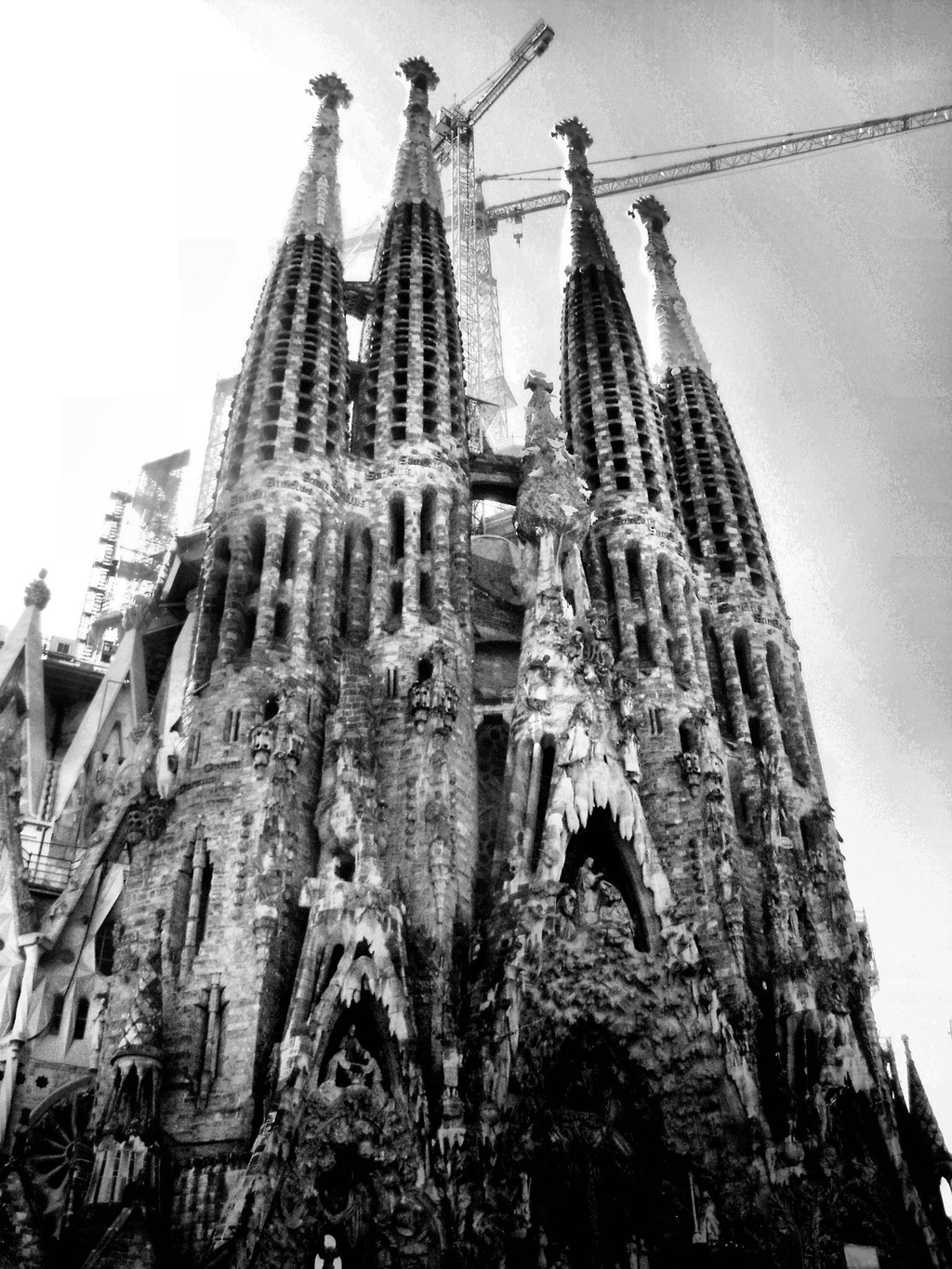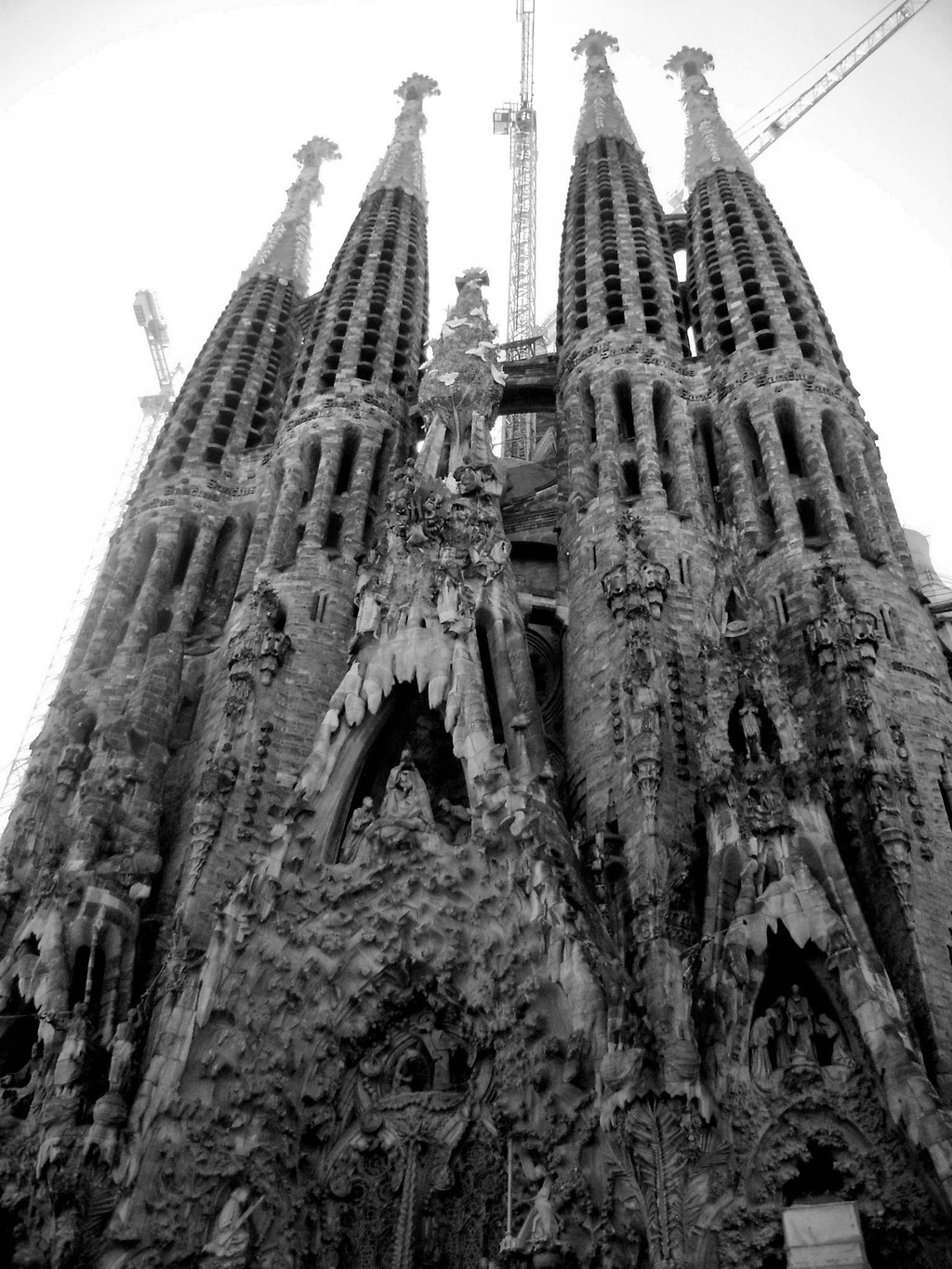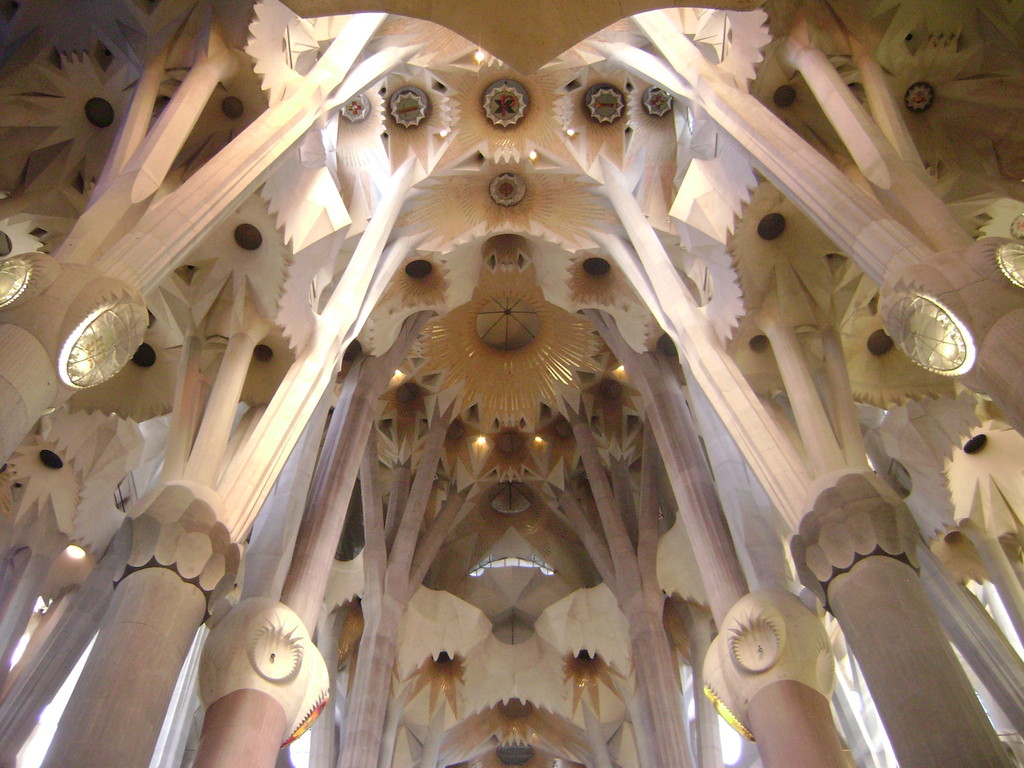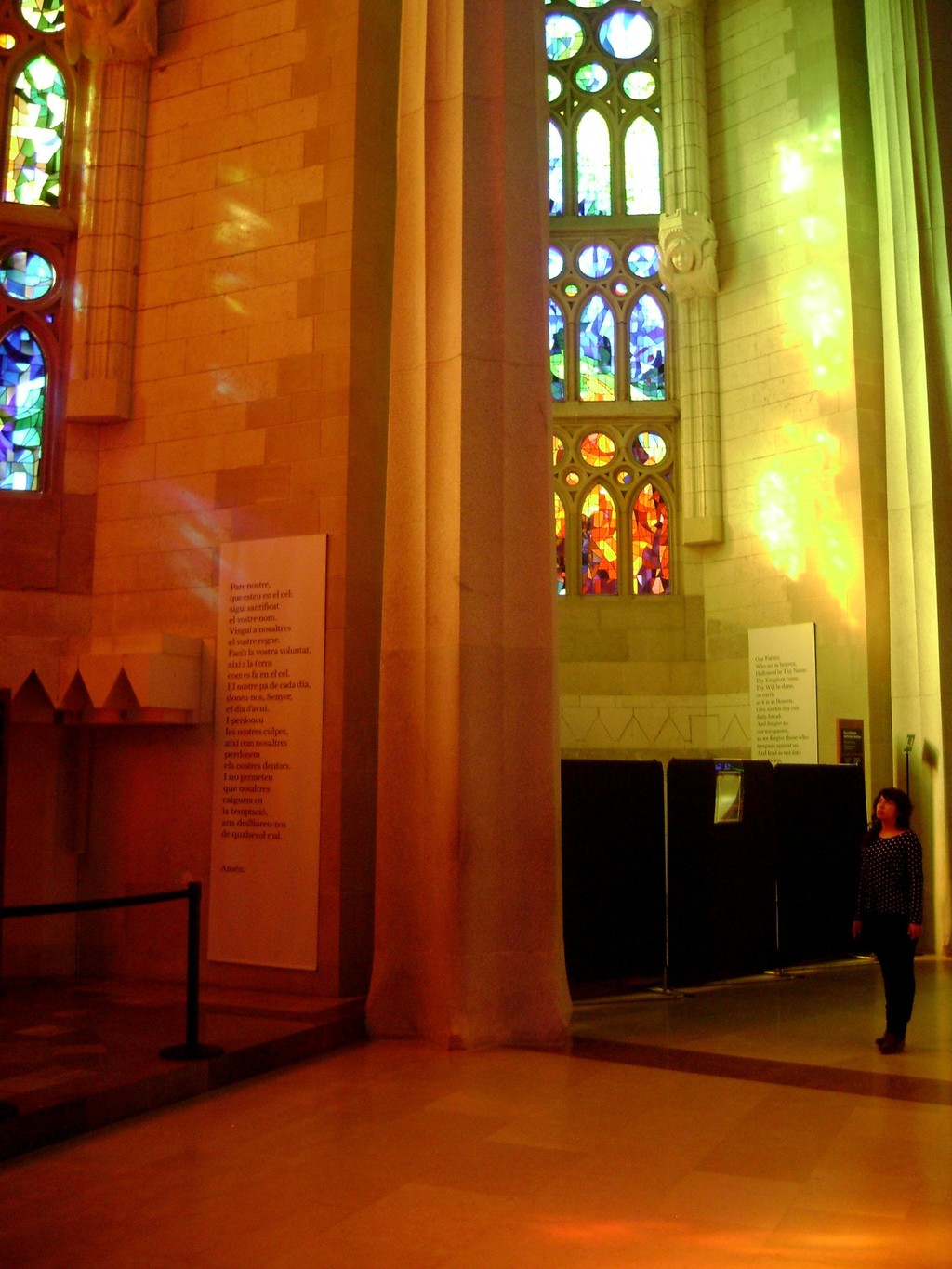The Eighth Wonder of the World (1)
The Great Wall of China, the ancient city of Petra in Jordan, the statue of Christ the Redeemer in Brazil, the ruins of Machu Picchu in Peru and those of Chichen Itza in Mexico, the amphitheatre called Colosseum in Rome, the temple of Taj Mahal in India, the Great Pyramid of Giza in Egypt. Do you know what these seven places have in common? Easy, isn't it? They are regarded as the New Seven Wonders of the Modern World, according to a vote which elected them as the heirs of the 7 Wonders of the Ancient World in 2007. Well, I dare saying that if we were to decide about adding one more monument to this list, the most rightful candidate would be, without any doubt, the temple of La Sagrada Familia in Barcelona.
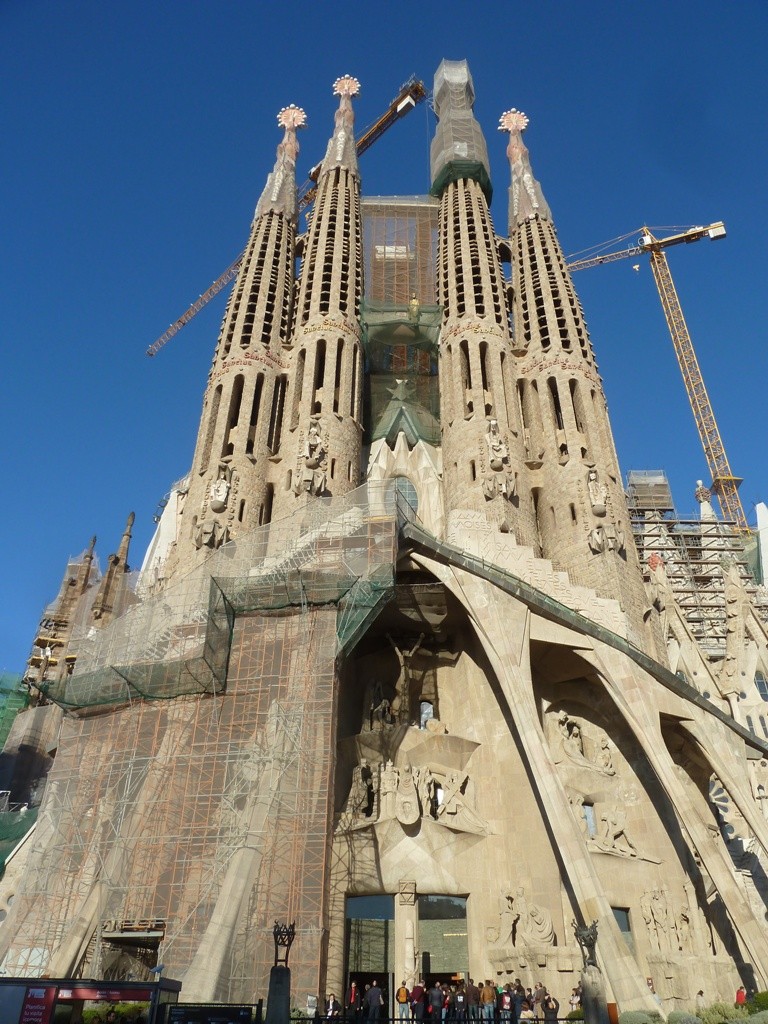
Most of you will be probably rolling with laughter after reading my statement. I can understand them quite well because until you have not visited the place with all the due care it is not possible to be aware of its greatness. And I am afraid that, even for a good number of people who have been there, it is not easy to appreciate fully its immense charm, the immense meaning that it implies. It is not that I am boasting with superior knowledge and sensibility than average people. It is simply a question of spiritual capability:
La Sagrada Familia is not simply a massive church, an unbelievable artistic monument, an extraordinary (if not inexplicable) wonder of architecture. It is a temple, and as a temple its main aim (according to the clear and firm will of its creator) is putting men in relation to their God. As a believer, I have the great advantage to be quite accustomed to establish this kind of contact. And yet, in such a place as La Sagrada Familia it is not possible for anybody to fail in catching at least a sparkle of this spiritual relationship; provided that they visit the temple in the right fashion, which of course does not mean sticking their ear to the mobile phone or chattering throughout the visit.
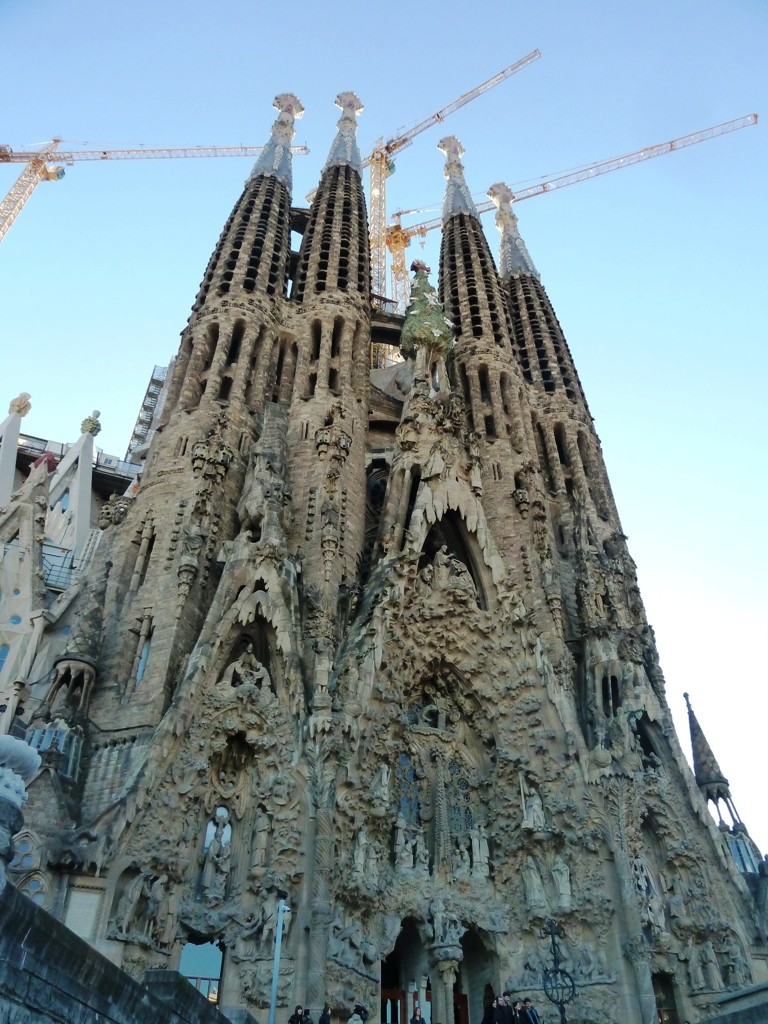
Nevertheless, as I am afraid I have not been of much help so far for those of you who are planning to visit the temple, I had better gone by order and should leave aside, at least for the moment, my personal observations. First and foremost, I would like to point out that La Sagrada Familia is the place to be seen in Barcelona. No matter how limited the time you may have at disposal, you really must not miss this unique landmark. As most Modernist buildings located in the district of L'Eixample, it is easily reachable by underground, stepping off the L2 or L5 line train at the dedicated stop. It is definitely a good idea to buy your ticket online in order to avoid endless queues at the ticket offices; if possible, try to go quite early in the morning: It should be easier to avoid the tourist masses which inevitably crowd the temple.
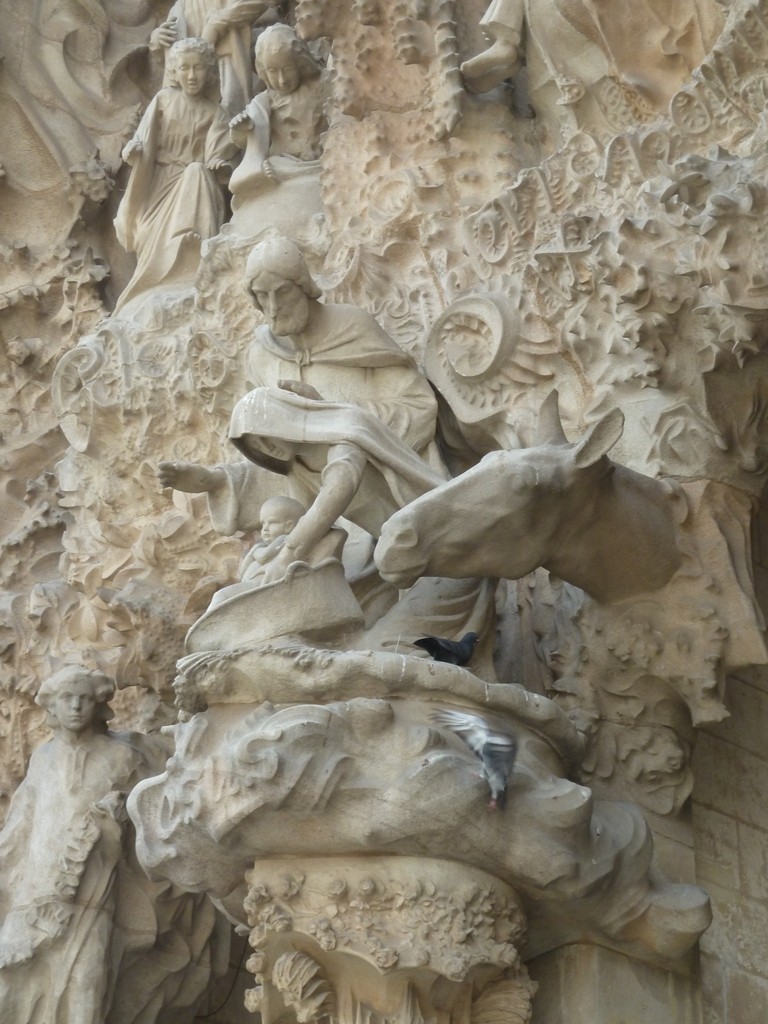
If on the one hand it is possible to see most of the outside part of the building without paying, I must warn you that it is just a fallback option, only to be chosen in case that you have very little time, as you will not be able to appreciate most of the charm of the place this way. And after all, the price is not that high: The entrance costs 15€ per person, while a 20€ ticket includes also the visit to one of the towers. Consistent reductions are available for students, children and people with disabilities, while with an additional cost of about 3€, it is possible to have an audioguide (which I definitely recommend). The entrance fee, which is anyway much cheaper than others in Barcelona (such as Camp Nou or Casa Batllò), is fully justified in my opinion, as the funds raised are obviously an important contribution to the works needed to complete the temple.
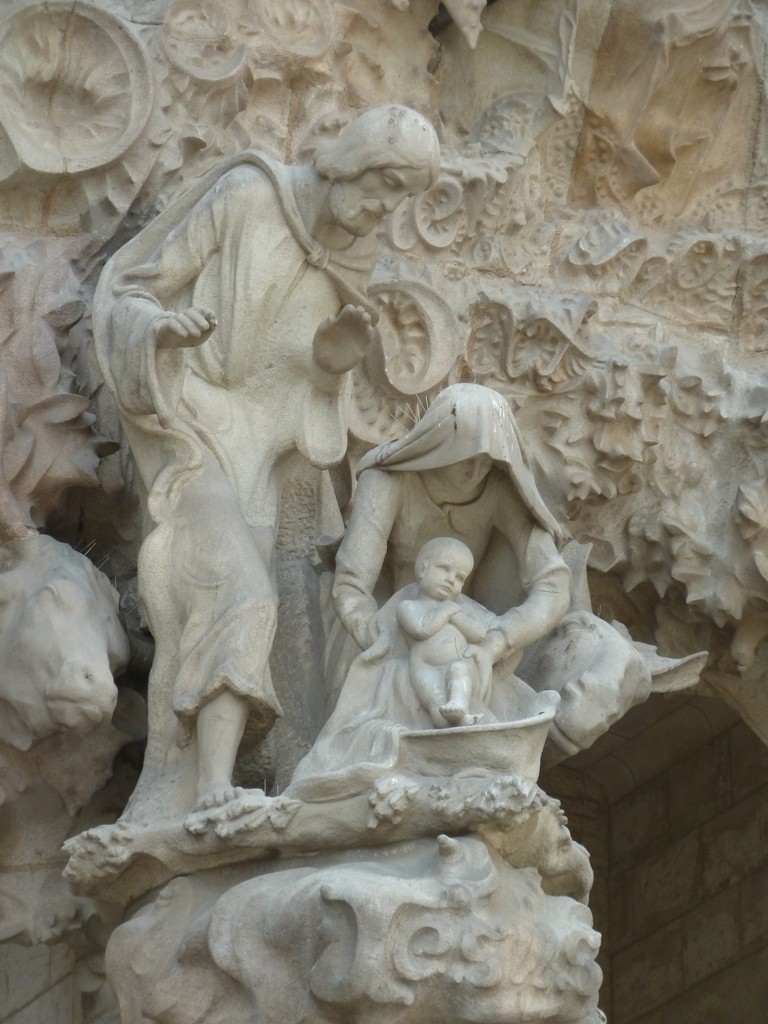
You may be wondering how it is possible for a building whose construction started in 1886 to be still unfinished. Well, the incompleteness is, at least for the moment, one of the main features of La Sagrada Familia (if not the main one). The reason for it probably lies in at least two motives: the incredibly ambitious project conceived by Gaudi, almost defying the limits of the human faculties, and the tormenting series of events which the church (and the city) have gone through in the last century or so. The history of the temple is so unique that it deserves to be briefly summed up: When in 1883 Antoni Gaudi replaced another local architect to whom the project of a new church had been entrusted, he planned to build a temple able to accommodate 13. 000 people.
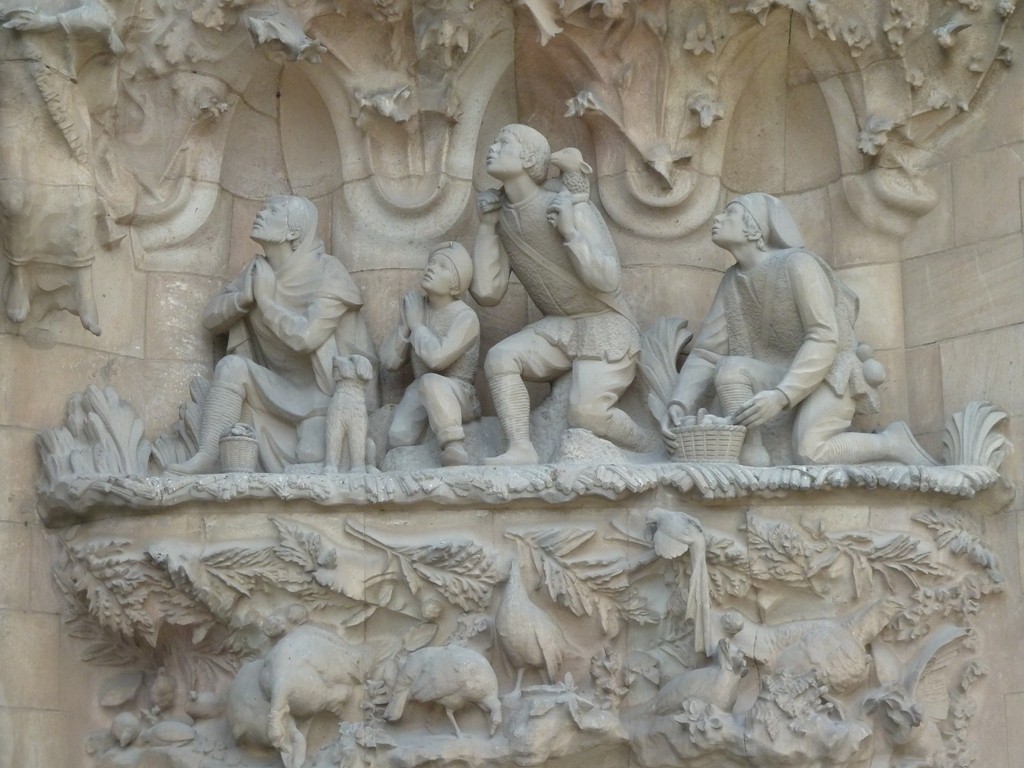
The plan was so ambitious that the money for the construction soon began to run short, and when they finally ran out of it Gaudi himself started looking for financers and doing everything in his power to raise funds. When the architect died in 1926, having spent all its money on a project which had become his only mission and obsession, the crypt, a part of the apses and one of the four facades had been completed. To make it worse, when the Civil War broke out in 1936, the anarchists profaned the building, destroying the inner part and, above all, the projects and models left by Gaudi. It was only in 1952 that the construction works were resumed, following computer-designed projects which were realised on the basis of what was left from Gaudi's work.
A controversy was aroused, though, by those who argued that the new plans were not compliant with the ideas and the style of the creator. A new facade was completed in 1976, to which some sculptures by the Catalan artist Josep Maria Subirachs were added in the following decades. Also, with reference to this a heated debate followed, the construction work went on and in 2010 the roof was finally completed, enabling Pope Benedict XVI to consecrate the temple with a solemn celebration.

As I have just shown summarising the history of the temple, La Sagrada Familia is not a common monument, but rather an unusual place whose story has not been totally written yet. Nevertheless, the consistent part of the building which we can already admire is really worth a closer examination. The Nativity Façade is the only of the four (nearly) completed during Gaudi's life. Built in a peculiar kind of brownish stone, it is characterised by an incredible abundance of decorations. Gaudi conceived it as divided into three parts, representing the three Christian virtues of Hope, Charity and Faith. The main scene portrayed is obviously the Nativity, but other tableaux are devoted to the Annunciation, the Flight into Egypt, the Massacre of the Innocents and the Presentation of Jesus at the Temple.
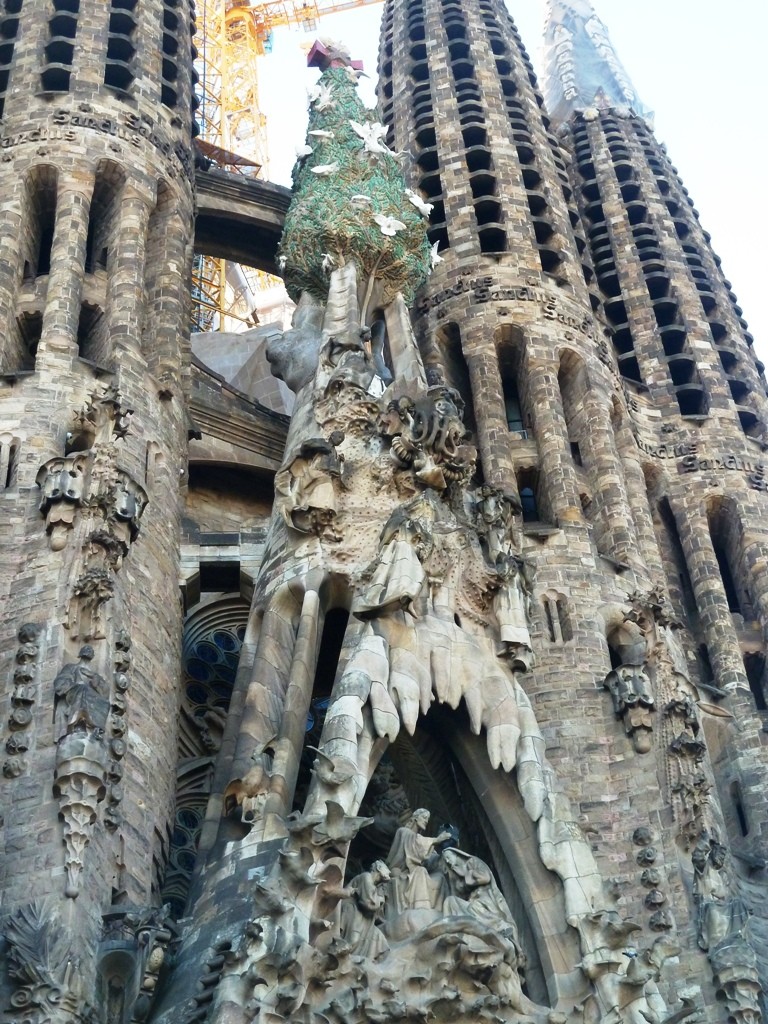
The details typifying the various characters (the shepherds, the Wise kings) are of striking beauty, and it is interesting to point out that Gaudi used to derive the faces of the character from those of local people, using a plaster mold. Notice also the abundance of wildlife species placed just below the characters: They are plants and animals typically found in Catalonia, aiming to show the involvement of all the creation come to the birth of Jesus. A similar function is entrusted to one of the most remarkable features of the facade, the so-called Tree of Life, which stands out with its green colour from the uniform brown hue of the facade.
Photo gallery
Content available in other languages
- Français: La huitième merveille du monde (1)
- Polski: Ósmy Cud Świata (1)
- Español: La Octava Maravilla del Mundo (1)
- Português: A Oitava Maravilha do Mundo (1)
- Türkçe: Dünya'nın Sekizinci Harikası (1)
- Italiano: L'ottava meraviglia del mondo (1)
- Deutsch: Das achte Weltwunder (1)
- Nederlands: Het achtste wereldwonder (1)
The Eighth Wonder of the World (2)
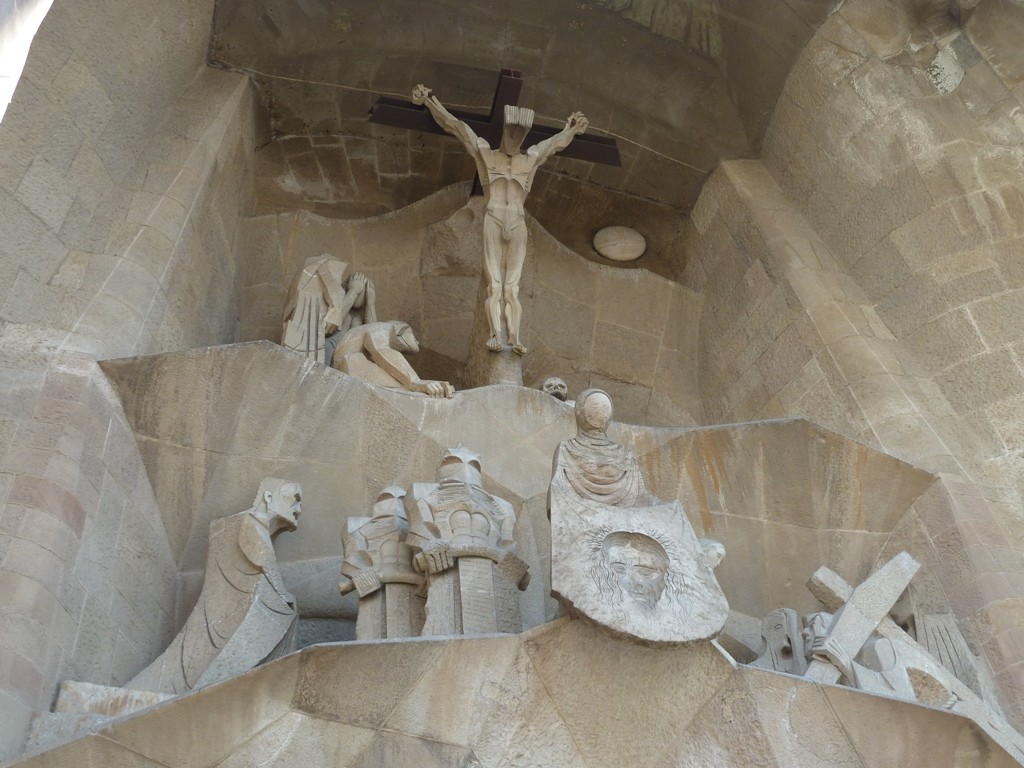
Of a rather different kind, instead, is the Facade of the Passion, realised in the second half of the 20th century and adorned by the works of Josep Maria Subirachs. Actually the contrast between the two architectonic styles (and even the kinds of stones used) is really outstanding, but it seems that such a difference was included in Gaudi's original plan. Indeed, if the former was aimed to celebrate the cheerfulness of the world for the birth of the Saviour, the latter is devoted to the sufferings of Christ for the main kind.
The Facade of the Passion, therefore, was not meant to bear excessive ornaments, its focus being on the various scenes depicting the last days of Jesus on earth. Undoubtedly, it is with a rather hard style that Subirachs modeled the sculptures, whose sharp outlines are perhaps at odds with Gaudi's belief that the straight line is not to be used as it does not exist in the natural world. Nevertheless, there is no doubt that the artist succeeded in conveying the powerful meaning that these tableaux entail. It is not possible, indeed, to observe the Crucifixion, the scene of Judas's kiss and those of the arrest of Jesus and his agony in bearing the cross without feeling some strong emotions aroused.
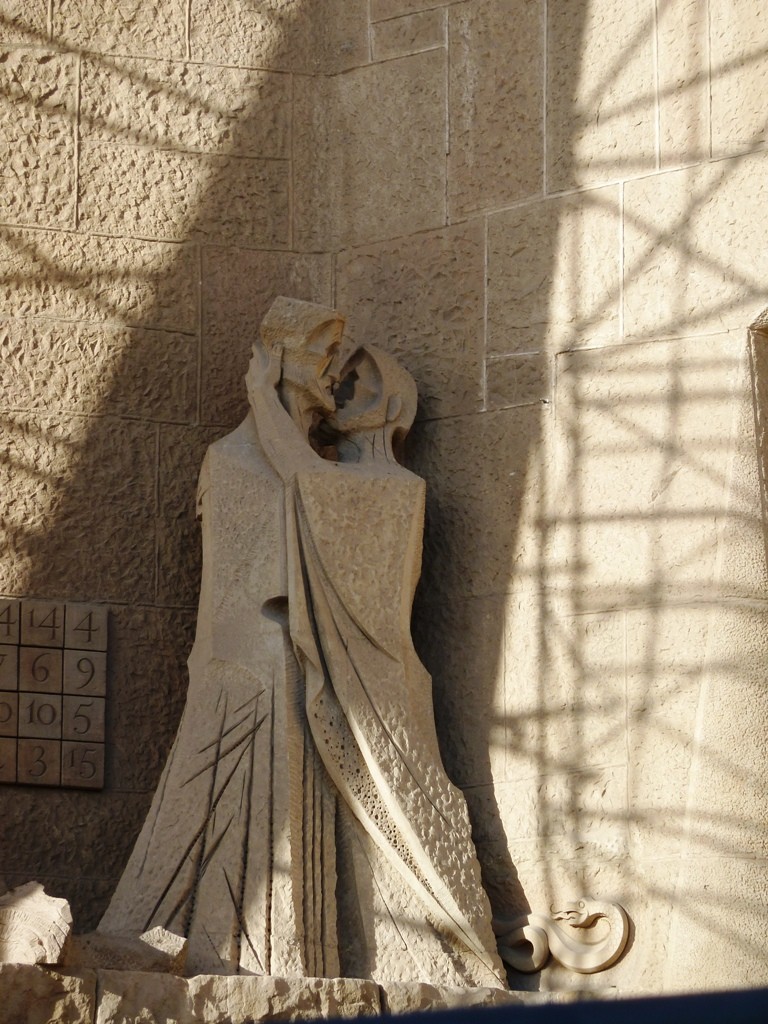
Once again, as usual when dealing with one of the creations of Gaudi, even the smallest details matter. Notice for example the square placed next to the tableau of Judas's kiss, on which some series of numbers are carved. Of course, there is a precise meaning in them, and I will not tell you which because it is quite easy to work out (let us say that it was a sort of Sudoku ante litteram... ). More features of interest are found in the tableau placed just below the Crucifixion. If you have visited la Pedrera, you will probably notice that the outline of the Roman soldiers standing on the left have been modeled on the basis of the sculptures found on the roof of Casa Milà. It is not possible to guess that the visage of the man standing on their left, representing the evangelist witnessing the scene, has been patterned after a photography of Gaudi himself. A sort of hidden tribute which Subirachs bestowed to the great master. Notice finally that the chronological sequence of the scenes starts from the Last Supper, located bottom-left, going then to the right and then raising to the second and third level, following a sort of S pattern.
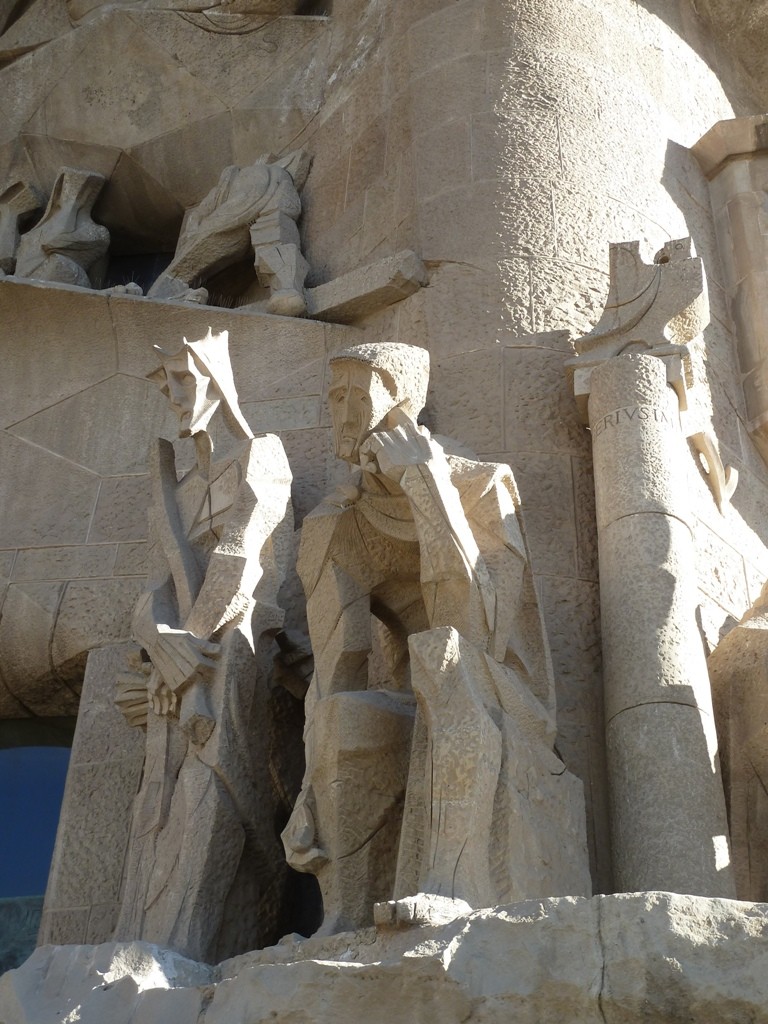
As for the inner part of the church, it is not less extraordinary than the outside. Having gone through the main door (do not fail to notice the engraving on the door and on the floor immediately before entering the church), within a few seconds you will probably be lost in awe, feeling once again a sort of spiritual elation. The wonderful light filtering from the stained glass windows is probably the first thing you will notice: according to Gaudi's belief that the light in a church must not in excess, but rather to the right extent which makes worship, contemplation and meditation possible, the atmosphere is quite suffused, and yet really enchanting.
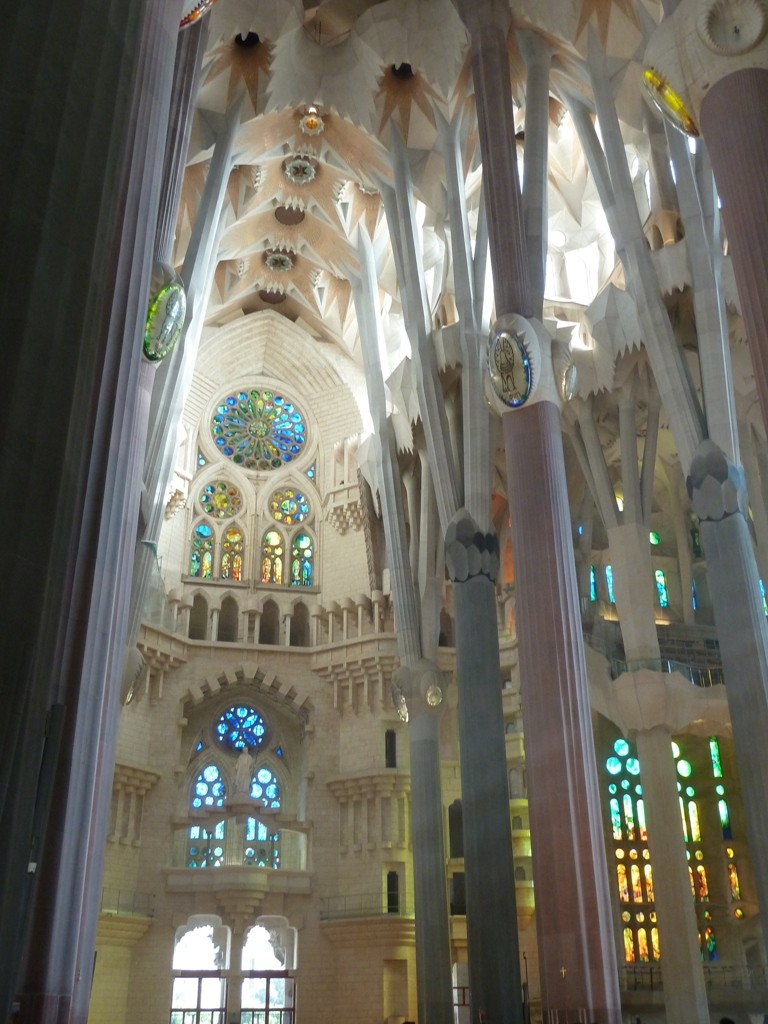
You had better hire an audio-guide to know more about the details of this extraordinary church. However, some elements are quite evident that may be noticed even by an unlearned visitor as myself. The columns, indeed, are realised using four different kinds of stone, differing also in the colour. Far from spoiling the harmony of the temple, though, this variety contributes to its uniqueness. The main entrance is located on the eastern side, where a statue of Sant Jordi (Saint George, the patron of Catalonia) is located.
Not by chance, that is the side where the sun rises every morning, casting therefore a magic shaft of light into the church. No sun light, instead, comes from the opposite side, when the statue of Christ on the cross is placed, surrounded by a series of ears of wheat and bunches of grapes. I would recommend you to stop for a while in silence and pray in front of the sacred image. Though the multi-coloured light of the stained windows has such a powerful effect that you may be amazed and almost dazed, do not fail to notice the peculiar structure of the columns. Looking up towards the ceiling, instead, you will have the impression of catching sight of a forest of thin branches, an effect created by the ramification of the columns which resemble, in this way, towering stone trees.
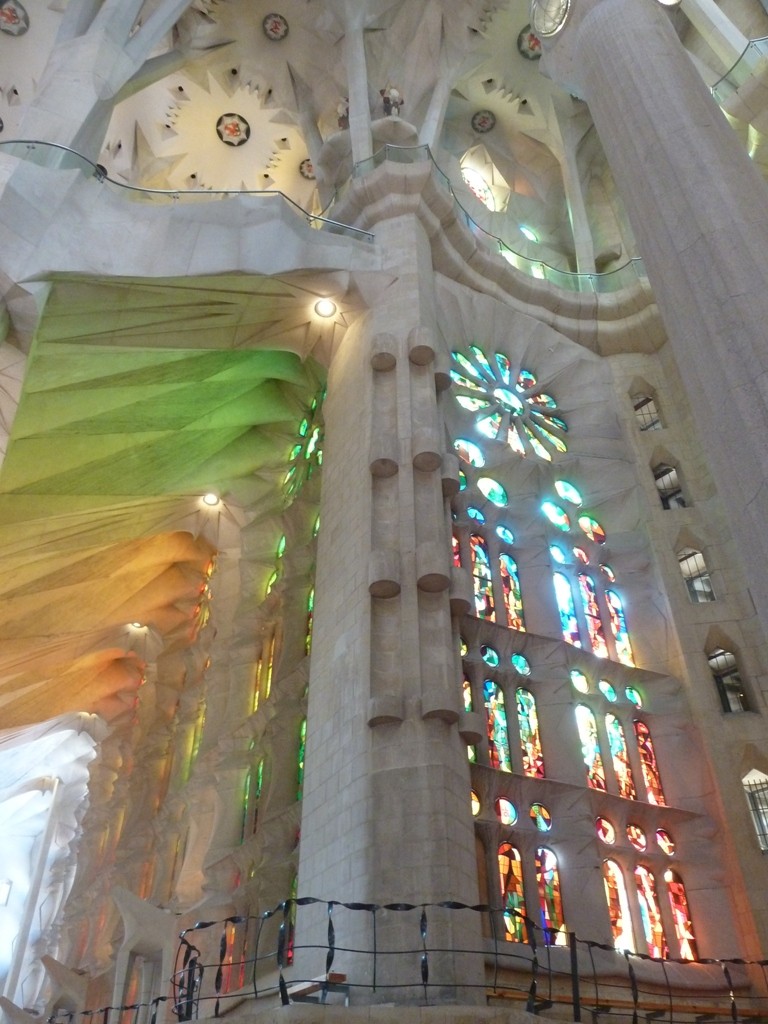
As I was saying at the beginning, the church is far from be completed yet, though it is thought that it will be so by the year 2030. The main part still missing is the third and last facade, called Facade of the Glory, where the resurrection of Christ will be celebrated. The only part which are visible at the moment are some colourful pinnacles resembling the ones of Palau Guell, which Gaudi would have probably appreciated. The towers are another important missing element: the original project featured 17 towers quite alike to each other, plus one really outstanding which is meant to reach an height of 170 metres. However, only 8 of them have been currently built, not including, of course, the main one. A rather difficult challenge, which nevertheless has been undertaken.
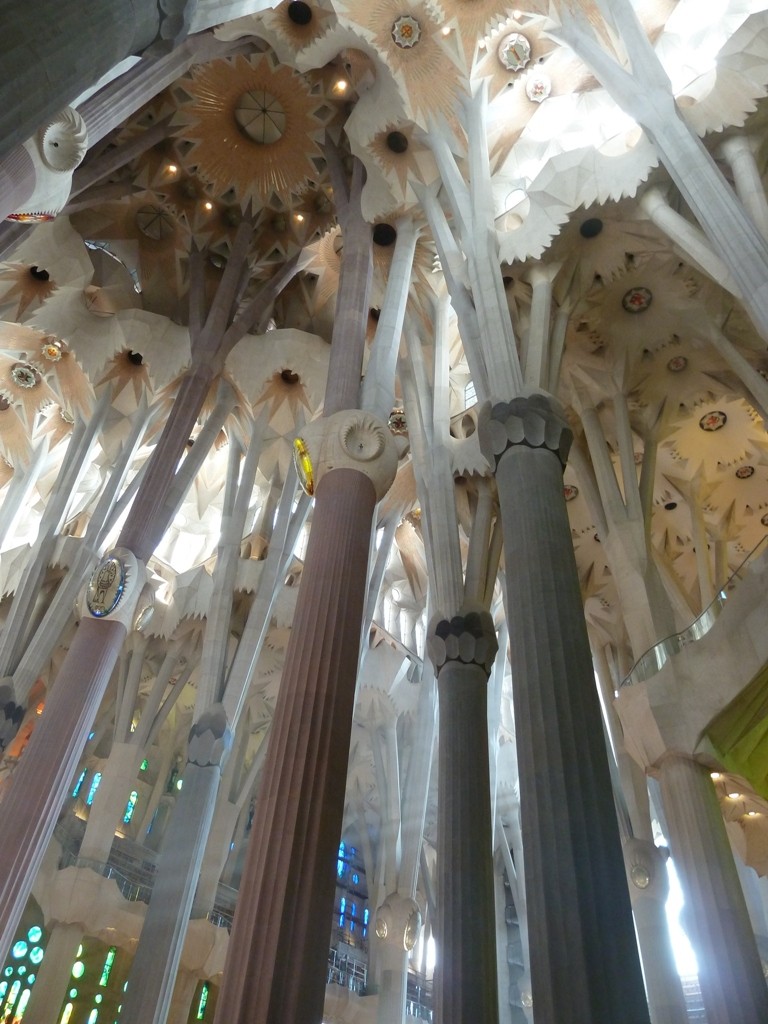
Again, the towers deserves further attention, as their number and disposition is far from accidental (dealing with Gaudi, it would not have been possible). The 12 towers located on the three facades stands (or rather will stand, as only 8 of them have been completed) for the apostles, while the highest tower obviously represent Christ. Around it, four more towers (measuring about 100 metres, like the ones of the apostles) will symbolise the 4 evangelists, and a final one towering over the apses will be the symbol of the Holy Mary.
Given his notorious aversion for the straight line, Gaudi gave the towers a characteristic curving outline. It is said the source of inspiration for such a peculiar shape were the peculiar peaks of the Montserrat mountain range. As for the decorations, the existing towers are characterised by spectacular pinnacles decorated by fine mosaics. It seems that, as a reply to the remark that nobody would have been able to see such an elaborate decorations, Gaudi is believed to have said "The angels will see them".
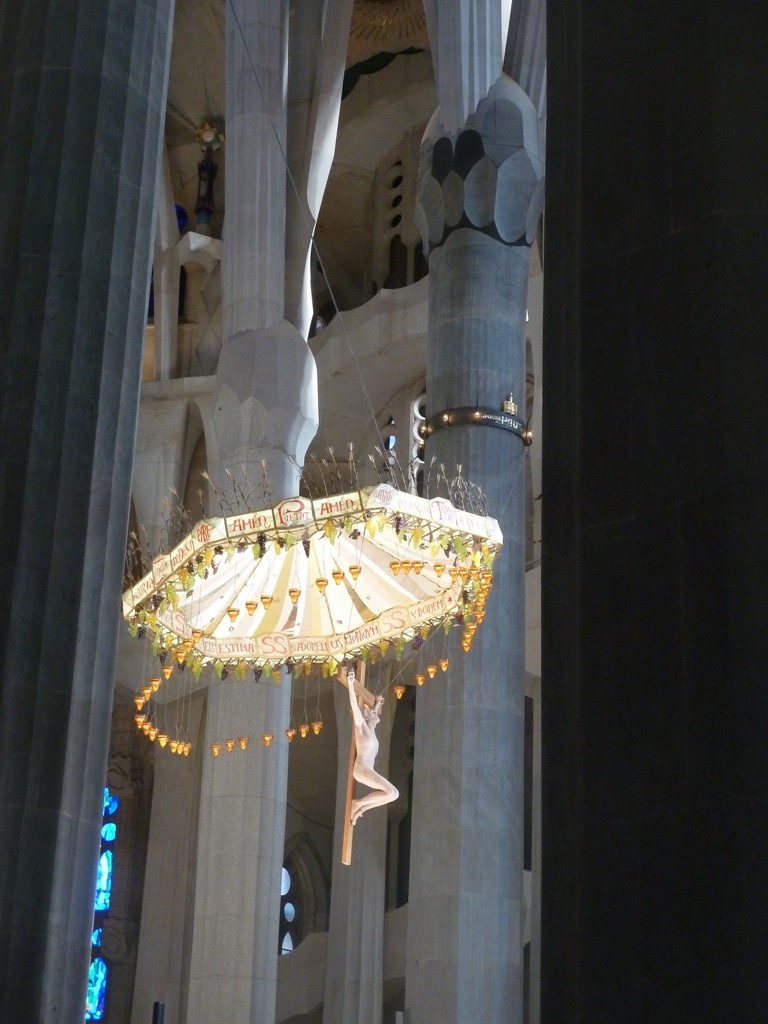
This curious (but quite meaningful) remark brings me back to the personal observations I was making at the beginning. I will content myself with adding just a couple of things, otherwise this entry will be as endless as the present condition of La Sagrada Familia (though far less interesting). Of course, everybody is free to go and visit the temple the way they prefer. Although, a full understanding of the original project (which I hope will be made reality within a few decades) is not possible if overlooking the spiritual component of the place.
Coming to an end of this large entry (though there would be still much to say about the crypt, the apses, the small and interesting cloister called Claustre del Roser), I would like to conclude with a parallelism drawn from the biblical tradition. I like to think, indeed, that if the Tower of Babel was built aiming to reach the sky, demonstrating in that fashion the power of mankind, such an extraordinary building as La Sagrada Familia, though perhaps challenging the artistic and architectural standards, is aimed at bringing mankind closer to God.
Photo gallery
Content available in other languages
- Français: La huitième merveille du monde (2)
- Italiano: L'ottava meraviglia del mondo (2)
- Polski: Ósmy Cud Świata (2)
- Español: La octava maravilla del mundo (2)
- Deutsch: Das Achte Weltwunder (2)
- Português: A Oitava Maravilha do Mundo (2)
- Türkçe: Dünyanın Sekizinci Harikası (2)
L'ottava meraviglia del mondo (1)
La Grande Muraglia Cinese, l'antica città di Petra in Giordania, la statua di Cristo Redentore in Brasile, i resti di Machu Picchu in Perù e quelli di Chichen Itza in Messico, l'anfiteatro chiamato Colosseo a Roma, il tempio del Taj Mahal in India, la Grande Piramide di Giza in Egitto. Sapete cos'hanno in comune questi sette posti? Facile vero? Sono considerati le 7 meraviglie del mondo moderno, secondo una votazione che nel 2007 li ha eletti eredi delle 7 meraviglie del mondo antico. Bene, mi azzardo ad affermare che se dovessimo decidere di aggiungere un ulteriore monumento a questa lista, il candidato più legittimo sarebbe, senza ombra di dubbio, il tempio della Sagrada Familia a Barcellona.
La maggior parte di voi si staranno probabilmente rotolando per le risate dopo questa mia affermazione. Posso capirli benissimo, dato che finché non si visita questo luogo con la dovuta attenzione non è possibile rendersi conto della sua grandezza. E temo proprio che, anche per una buona parte delle persone che vi sono state, non sia facile saper apprezzare pienamente il suo immenso fascino, il grande significato che esso implica. Non è che mi stia vantando di avere una conoscenza ed una sensibilità superiori della gente comune. Si tratta semplicemente di una questione di capacità spirituale: la Sagrada Familia non è solo una chiesa enorme, un monumento incredibile dal punto di vista artistico, una straordinaria (se non inspiegabile) meraviglia dell'architettura. Essa è un tempio, e in quanto tale il suo scopo principale (secondo la chiara e ferma volontà del suo creatore) è quello di mettere l'uomo in relazione con Dio. In quanto credente, ho il grande vantaggio di essere abbastanza abituato ad instaurare questo tipo di contatto. Eppure, in un luogo come La Sagrada Familia, è impossibile per chiunque non riuscire a cogliere almeno una scintilla di questa relazione spirituale. Ammesso che si visiti il tempio nella maniera adeguata, il che naturalmente non significa avere l'orecchio costantemente attaccato al telefono o chiacchierare durante tutta la visita.
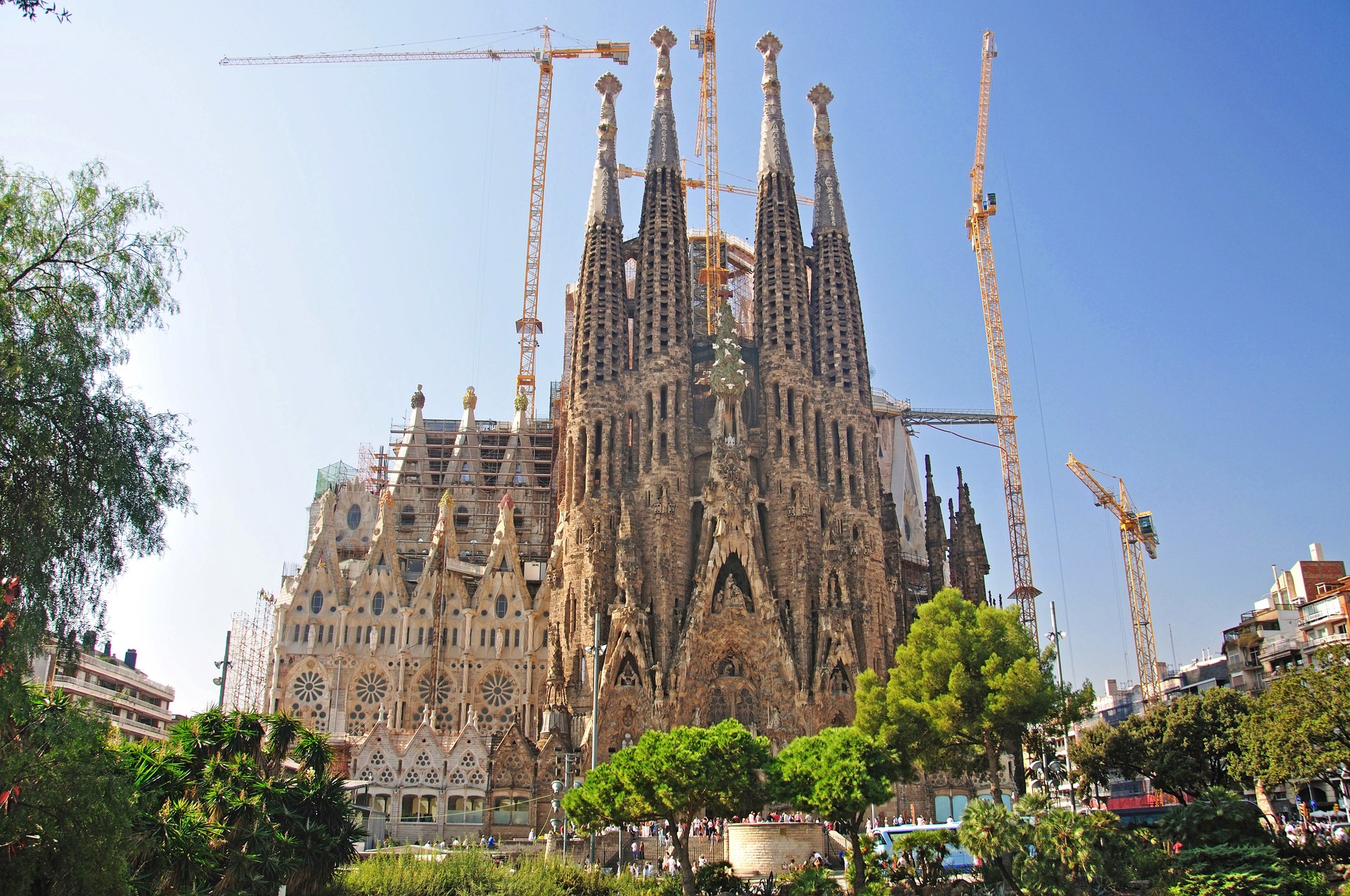
Nonostante ciò, dato che temo di non essere stato di grande aiuto finora a coloro che stanno pensando di andare a visitare il tempio, farò meglio ad andare con ordine e lasciare da parte, almeno per il momento, le mie osservazioni personali. Prima di tutto, lasciatemi dire che La Sagrada Familia è il posto da visitare a Barcellona. Non importa quanto limitato sia il tempo che avete a disposizione, non dovete davvero perdere questo monumento unico. Situato come molti edifici modernisti nel distretto dell'Eixample, è facilmente raggiungibile in metropolitana, scendendo dalla linea L2 o L5 all'apposita fermata. È decisamente una buona idea comprare i vostri biglietti online, in modo da evitare code infinite alle biglietterie; se possibile magari provate ad andare la mattina abbastanza presto: dovrebbe essere più facile evitare le folle di turisti che inevitabilmente si accalcano nel tempio.
Se da un lato è vero che si può vedere la maggior parte dell'esterno dell'edificio senza pagare, devo avvisarvi che si tratta solamente di una soluzione di ripiego, da scegliere soltanto nel caso abbiate davvero poco tempo, dato che in questo modo non riuscirete ad apprezzare molto del fascino di questo luogo. E dopo tutto, il prezzo non è poi così elevato: l'ingresso costa 15 euro a persona, mentre il biglietto da 20 euro comprende anche la visita ad una delle torri. Sconti considerevoli sono disponibili per studenti, bambini o persone con disabilità, mentre al costo aggiuntivo di 3 euro circa è possibile avere un'audioguida (ve la raccomando assolutamente). Il prezzo del biglietto, che ad ogni modo è assai minore rispetto ad altri posti di Barcellona (vedi il Camp Nou o Casa Batllò), è peraltro del tutto giustificato a mio modo di vedere, dato che i fondi così raccolti sono ovviamente un contributo importante ai lavori necessari per completare il tempio.
Vi starete forse chiedendo come è possibile che un edificio la cui costruzione cominciò nel 1886 possa essere ancora incompleto. Beh, diciamo che la sua incompletezza è, almeno per il momento, una delle caratteristiche distintive della Sagrada Familia (se non la principale). La ragione risiede probabilmente in almeno due motivi: il progetto incredibilmente ambizioso concepito da Gaudí, che arriva quasi a sfidare i limiti delle possibilità umane, e la tormentata serie di eventi che la chiesa (e la città di Barcellona) hanno attraversato nell'ultimo secolo circa. La storia del tempio è così straordinaria che merita di essere brevemente riassunta: quando nel 1883 Antoni Gaudí sostituì un altro architetto locale a cui era stato affidato il progetto di una nuova chiesa, pianificò la costruzione di un tempio che potesse ospitare 13. 000 persone.
Tuttavia, il progetto era talmente ambizioso che ben presto i fondi per l'edificazione cominciarono a scarseggiare, e quando infine terminarono Gaudí non esitò a cercare lui stesso patrocinatori e a fare ogni cosa in suo potere per raccogliere denaro. Quando nel 1926, dopo aver speso tutti i propri soldi nel progetto che era ormai divenuto una missione e un'ossessione, l'architetto morì, erano state completate solo la cripta, parte dell'abside ed una delle quattro facciate. A peggiorare ulteriormente le cose, quando nel 1936 scoppiò la Guerra Civile, gli anarchici profanarono il tempio, distruggendo la parte interna e, soprattutto, i progetti ed i modelli lasciati da Gaudí. Fu solo nel 1952, dunque, che i lavori della costruzione poterono riprendere, sulla base di progetti realizzati a computer sulla base di quanto era rimasto dell'opera di Gaudí. Sorse però una controversia, dato che c'era chi sosteneva che i nuovi piani non erano conformi con le idee e lo stile del creatore. Una nuova facciata fu completata nel 1976, alla quale furono aggiunte nei decenni successivi alcune decorazioni scultoree dell'artista catalano Josep Maria Subirachs. Anche in questo caso, ne derivò un acceso dibattito, ma i lavori proseguirono e nel 2010 il tetto fu infine completato, permettendo a Papa Benedetto XVI di consacrare la basilica con una solenne celebrazione.
Come ho appena mostrato riassumendo la storia dl tempio, La Sagrada Familia non è certo un monumento qualunque, quanto piuttosto un luogo fuori dall'ordinario la cui storia ancora non è stata scritta del tutto. Ciò nonostante, la considerevole parte dell'edificio che già possiamo ammirare merita davvero un esame accurato. La Facciata della Natività è l'unica delle quattro in programma ad essere stata (quasi) terminata durante la vita di Gaudí. Costruita con un tipo di pietra dal peculiare color marrone, è caratterizzata da un'incredibile abbondanza di decorazioni. Gaudí la concepì come divisa in tre parti, rappresentanti le tre virtù teologali della Speranza, della Carità e della Fede. La scena principale è ovviamente la natività (che dà il nome all'edificio), ma altri quadri secondari sono dedicati all'Annunciazione, alla Fuga in Egitto, alla Strage degli Innocenti ed alla Presentazione di Gesù al Tempio.
I dettagli che caratterizzano i vari personaggi (pastori, Re Magi) sono di una bellezza sorprendente, ed è interessante notare come Gaudí fosse solito ricavare i loro volti da quelli di persone comuni del posto, usando un calco in gesso. Notate anche l'abbondanza di specie animali e vegetali, collocate appena sotto i personaggi: si tratta di flora e fauna tipiche della Catalogna, che hanno l'obiettivo di mostrare il coinvolgimento di tutto il Creato alla nascita di Gesù. Una funzione similare è affidata ad uno degli elementi più notevoli della facciata. il cosiddetto Albero della Vita, che si staglia in forte contrasto con il suo vivace color verde sull'uniforme tinta marrone della facciata.
Photo gallery
Content available in other languages
- Español: La octava maravilla del mundo (1)
- English: The Eighth Wonder of The World
L'ottava meraviglia del mondo (1)
Di natura assai differente è invece la Facciata della Passione, realizzata nella seconda metà del Novecento e adornata con le opere di Josep Maria Subirachs. A dire la verità il contrasto tra i due stili architettonici (e perfino il tipo di pietra utilizzato) è davvero evidente, ma sembra che tale differenza fosse contemplata dal progetto originale di Gaudí. Se infatti la facciata precedente aveva lo scopo di celebrare l'allegria del Creato per la nascita del Salvatore, quest'ultima è dedicata alle sofferenze di Cristo per l'umanità. La Facciata della Passione, dunque, non doveva recare ornamenti eccessivi, dato che il centro dell'attenzione è posto sulle varie scene che raffigurano gli ultimi giorni della vita di Gesù sulla Terra.
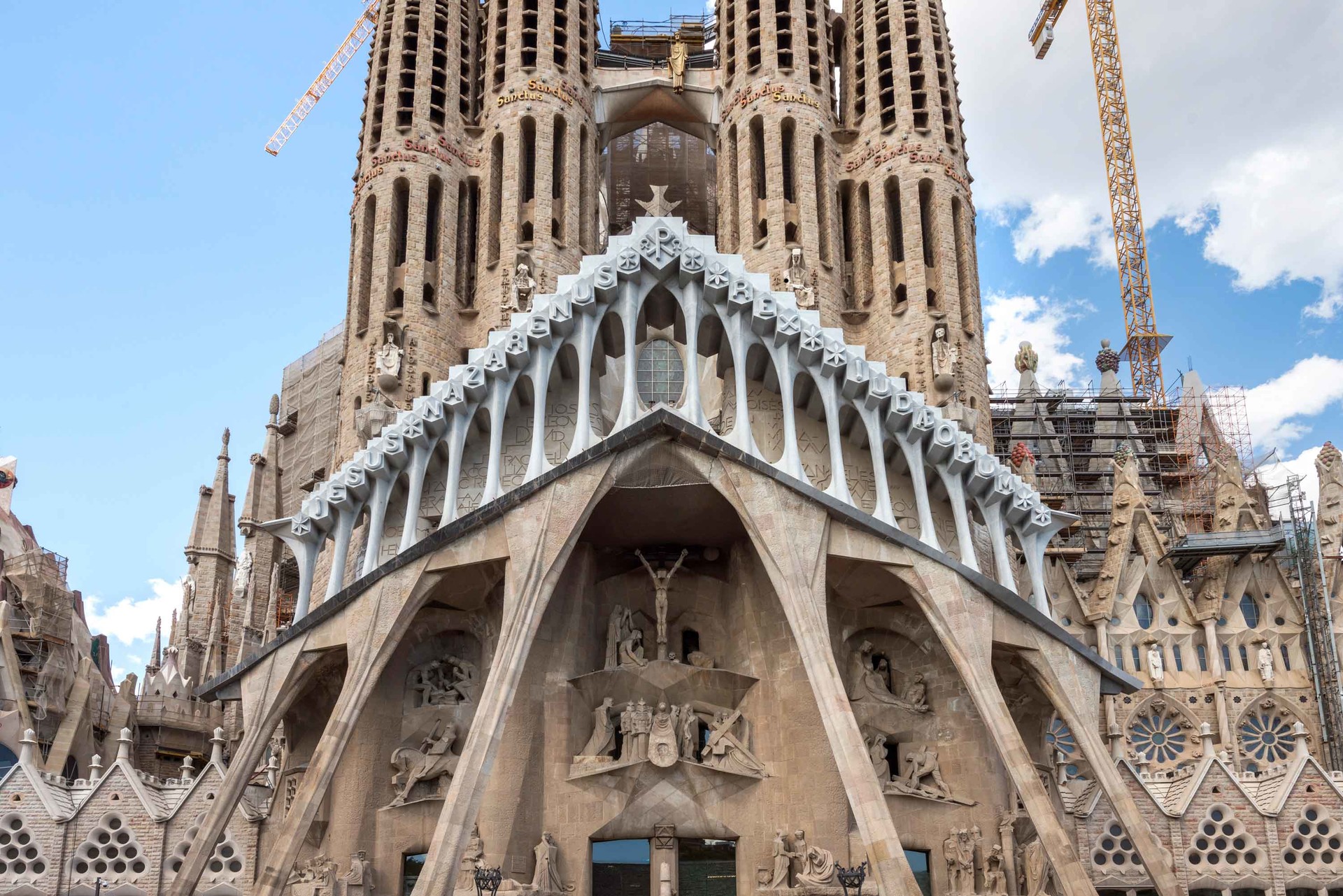
Indubbiamente, è con uno stile assai duro che Subirachs ha modellato le sculture, i cui profili spigolosi sono probabilmente agli antipodi rispetto all'idea di Gaudí che la linea retta non fosse da utilizzare in quanto inesistente nel mondo naturale. Tuttavia, non c'è dubbio che l'artista sia riuscito a trasmettere con successo il forte significato implicato da queste scene. Non è possibile, infatti, osservare la Crocefissione, la scena del bacio di Giuda o quelle del'arresto di Cristo e della sua agonia portando la croce senza sentir nascere emozioni davvero forti.
Ancora una volta, come sempre quando si parla di una delle creazioni di Gaudí, perfino i dettagli più piccoli contano. Notate per esempio il riquadro situato di fianco alla scena del bacio di Giuda, sul quale sono incise alcune serie di numeri. Naturalmente c'è un preciso significato dietro di essi, ma non vi dirò quale sia perché è abbastanza facile scoprirlo (diciamo che si tratta di una sorta di Sudoku ante litteram... ).
Ulteriori elementi di interesse si trovano nel quadro situato giusto al di sotto della Crocefissione. Se avete visitato la Pedrera, non potrete fare a meno di notare che la silhouette dei soldati romani in piedi sulla sinistra è stata delineata sulla base delle sculture che si trovano sul tetto di Casa Milà. E' invece impossibile indovinare che il viso dell'uomo in piedi sulla sinistra, raffigurante l'evangelista che assiste alla scena (Giovanni), è stato plasmato servendosi di una fotografia dello stesso Gaudí. Una sorta di omaggio nascosto che Subirachs volle tributare al grande maestro, insomma. Infine, notate come l'ordine cronologico delle scene sia una sequenza che comincia dall'Ultima Cena, situata in basso a sinistra, per poi passare sulla destra e risalire al secondo e terzo livello, formando una sorta di S.
Per quanto riguarda l'interno della chiesa, non è certo meno straordinaria rispetto all'esterno. Una volta attraversata la porta d'ingresso (non mancate di notare le incisioni sulla porta e sul pavimento immediatamente antistante l'ingresso in chiesa), nel giro di pochi secondi sarete probabilmente persi nella meraviglia, sentendo ancora una volta di percepire una sorta di estasi spirituale. La splendida luce che filtra dalle vetrate colorate è con ogni la prima cosa che salta all'occhio: secondo la convinzione di Gaudí, la luce nelle chiese non deve essere eccessiva, ma piuttosto presente nella misura giusta per rendere possibile il culto, la contemplazione e la meditazione. L'atmosfera è perciò abbastanza soffusa, eppure davvero incantevole.
Farete meglio a noleggiare un'audioguida per saperne di più riguardo ai dettagli di questa chiesa straordinaria. Tuttavia, alcuni elementi sono tanto evidenti da poter essere notati perfino da un visitatore inesperto come il sottoscritto. Le colonne, infatti, sono realizzate usando 4 diversi tipi di pietra, che differiscono anche nel colore. Lungi dal guastare l'armonia del tempio, tuttavia, questa varietà contribuisce alla sua unicità.
L'ingresso principale situato sul lato rivolto ad est, dove è situata una statua di Sant Jordi (San Giorgio, patrono della Catalogna). Non a caso, si tratta del lato su cui sorge il sole quotidianamente, gettando così un magico fiotto di luce verso la chiesa. Nessuna raggio solare, invece, proviene dal lato opposto, dove è collocata la statua di Cristo in croce, circondato da una serie di spighe di grano e grappoli d'uva. Vi consiglio di fermarvi per un attimo in raccoglimento davanti a questa immagine sacra. Sebbene la luce variopinta delle vetrate crei un effetto talmente incantevole da rimanere affascinati e persino ammaliati, non mancate di notare la peculiare struttura delle colonne. Alzando lo sguardo al soffitto, infatti, avrete l'impressione di vedere una foresta di rami sottili, un effetto creato dalla ramificazione delle colonne che somigliano, in questo modo, ad altissimi alberi di pietra.
Come dicevo all'inizio, la chiesa è ben lungi dall'essere completata, sebbene si pensi che possa esserlo entro l'anno 2030. La parte principale tra quelle ancora mancanti è senza dubbio la terza ed ultima facciata, detta Facciata della Gloria, dove sarà celebrata la resurrezione di Cristo. L'unica parte al momento visibile sono alcuni variopinti pinnacoli, davvero simili a quelli di Palau Guell, che Gaudí avrebbe probabilmente apprezzato. Un'altra assenza importante è quella delle torri: il progetto originale ne prevede 17, abbastanza simili tra loro, più una davvero straordinaria che sarebbe destinata a raggiungere un'altezza di 170 metri. Tuttavia, solo 8 di esse sono state per ora costruite, esclusa naturalmente la più alta. Una sfida assai difficile, che però è stata ormai intrapresa.
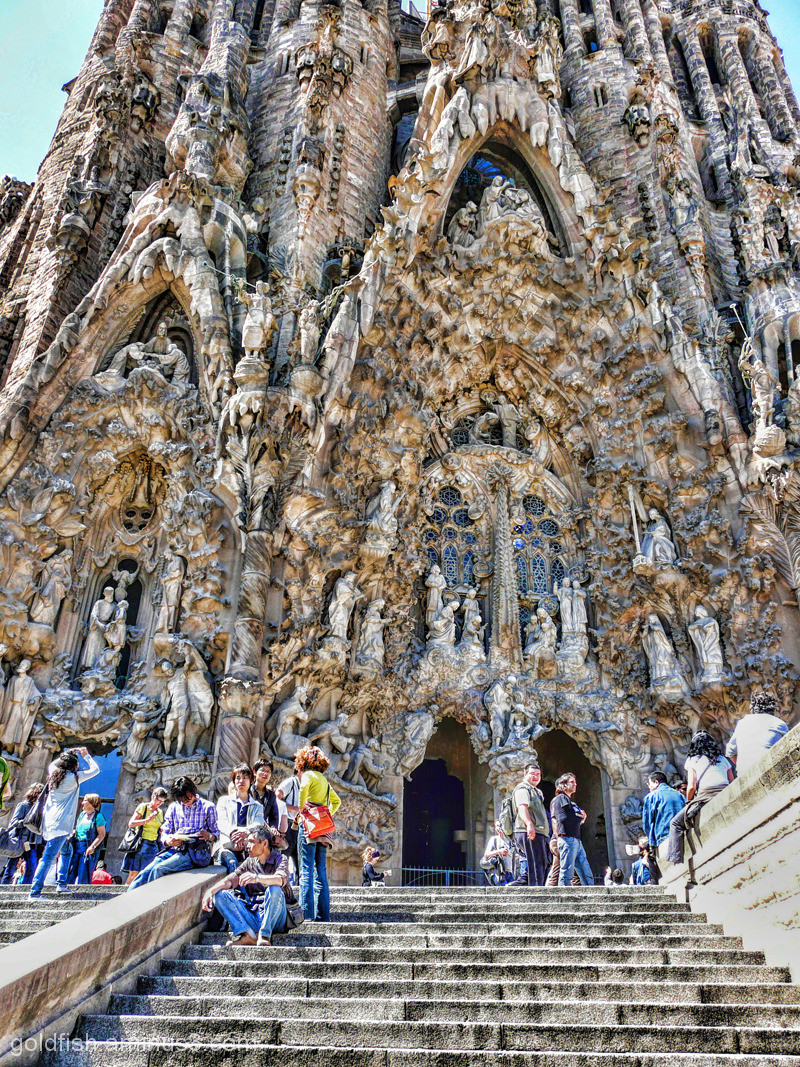
Ancora, le torri stesse meritano ulteriore attenzione, dato che il loro numero e la loro disposizione è tutt'altro che casuale (trattandosi di Gaudí, d'altro canto, sarebbe stato impossibile). Le 12 torri collocate sulle tre facciate simboleggiano (o meglio simboleggeranno, dato che solo 8 di esse sono state completate) gli apostoli, mentre quella più alta sarà ovviamente emblema di Cristo. Intorno ad essa, 4 torri ulteriori rappresenteranno gli evangelisti, mentre un'ultima torre, svettante sull'abside, sarà il simbolo della Madonna.
Data la sua notoria avversione per la linea retta, Gaudí diede alle torri un particolare profilo curvilineo. Si dice che la fonte di ispirazione per una forma tanto peculiare siano stati gli strani picchi delle montagne di Montserrat.
Per quanto riguarda le decorazioni, le torri esistenti sono caratterizzate da spettacolari guglie con rivestimento a mosaico. In risposta all'osservazione che nessuno avrebbe potuto ammirare decorazioni tanto elaborate, sembra che Gaudí abbia detto "Le vedranno gli angeli".
Questa precisazione curiosa (ma assai significativa) mi riporta alle osservazioni personali che stavo facendo all'inizio. Mi accontenterò di aggiungere un paio di cose, per evitare che questo post diventi senza fine come la condizione attuale della Sagrada Familia (per quanto molto meno affascinante).
Naturalmente, ognuno è libero di visitare il tempio nella maniera che preferisce. Tuttavia, una piena comprensione del progetto originale (che speriamo possa diventare realtà nel giro di pochi decenni) non sarà possibile senza tener conto della componente spirituale di questo luogo. Arrivando finalmente alla conclusione di questo post (per quanto ci sarebbe ancora molto da dire sulla cripta, sull'abside, sul piccolo ma interessante chiostro chiamato Claustre del Roser), vorrei concludere con un parallelismo tratto dalla tradizione biblica. Mi piace pensare, infatti, che se la Torre di Babele fu costruita con l'obiettivo di raggiungere il cielo, dimostrando in tal modo il potere del genere umano, un edificio straordinario com'è la Sagrada Familia, pur sfidando forse i canoni artistici ed architettonici, mira a portare l'umanità più vicina a Dio.
Photo gallery
Content available in other languages
- Español: La octava maravilla del mundo (1)
- English: The 8th wonder of the world
Basílica i Temple Expiatori de la Sagrada Família
The interior is special. It's very different from any church in which I was until now. It is very bright and airy. Gaudí was inspired from nature. In many of his works we find leaves, columns in the form of trees, etc. I had a closer look at the trees then. There are a few trees that really are extraordinary.
I do not know what variety they are but I liked them a lot and also the light through stained glass Windows, which creates amazing effects. On the Center, some chairs are separated by straps of warning, reserved for those who come to pray. There is a security guard who takes care that the people who sit on chairs are quite. There are many young people, who are eager to help you immediately, if you have a problem.
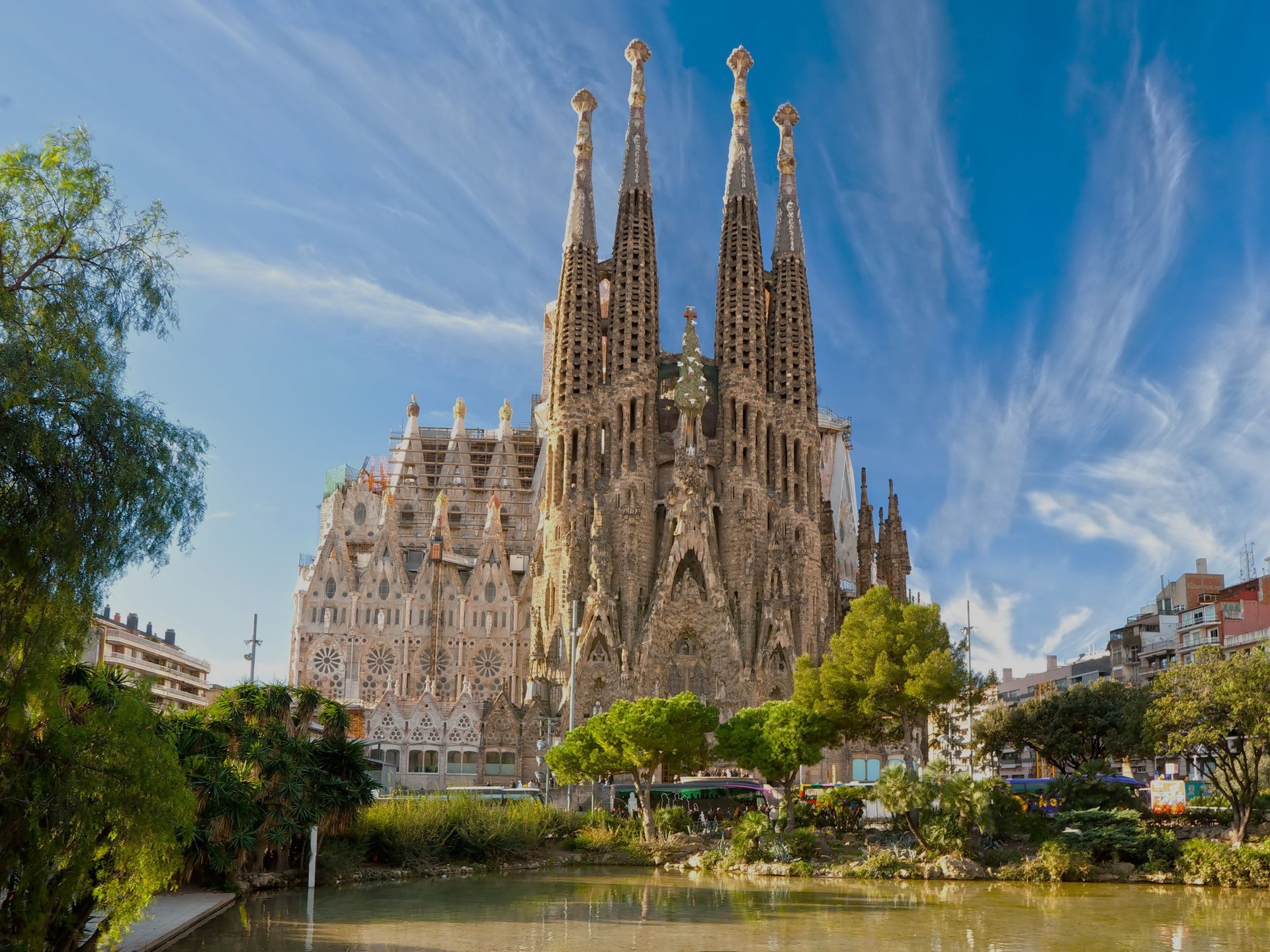
I had an open mouth for half an hour, then I went to the elevator. You must get out of the Church and you simply can’t miss the Nativity façade. Normally you have to queue for about 10 minutes. Each façade has four towers. You go up with the right elevator and then are spiral staircases. Pass on a bridge which unites the first two towers, and use the other two spiral staircases to get down again. From time to time there are kind of balconies, from where you can admire the scenery and take some pictures. I think it’s worth the money, this walk through the towers. Well, I liked it. The inner walls are full of scribbling, names, data, etc. Well at least they are not painted. They have big problems with gums which are pasted everywhere.
Back on Earth, I found a sizeable queue in front of the ticket offices and already began to regret not having bought the tickets in advance on the internet. All evil for good because while a part of the family stood in the queue, we went to McDonald's across the street and ate at "botu horse".
When you buy tickets you must say if you want to go up and in one of the towers on either the Nativity façade, or the Passion façade. On the ticket a time is stated, that tells you when to take the elevator to avoid crowds. We were given the hour 11:30, which was about one and a half hour after the purchase of the ticket. So, I had plenty of time to explore the Church, both on the inside and the outside.
I admired both façades from close. Different models used by Gaudí were explained and we saw what inspired him in nature. Then I went downstairs to the crypt, where another Museum is.
The most interesting thing in the crypt, in my opinion, is the pattern made by Gaudí, in which he tied sand bags with different strings, to create an image of the ceiling upside down. He made use of gravitational force to see if it's better than the columns to support the weight. Very interesting that pattern. Also in the crypt is Gaudí's tomb, but we've looked at it just through a window. The tomb is at a lower level. There were some people in there, but I never figured out where they had entered from.
Through the crypt, we could also see those who work in the basilica. They were doing all sorts of patterns. We saw architects and boys who made models of stone etc. Very interesting. Assisting at the construction of such a project is something special. It is worth visiting and I recommend you to climb up the towers. Well, I liked it. There are several documentaries about the Sagrada Família and also YouTube is filled with videos.

If you leave the Birth façade you will find a KFC Restaurant at the corner. You can continue the Avenue of Gaudí, in case you want to go to the Hospital Sant Pau.

I think it took us between an hour and an hour and a half visiting the Sagrada Família. One thing that I liked and I forgot to mention is: on the ticket is written: "The Basilica of the Sagrada Família is everybody's, and yours too. With your contribution the work can be finished. "
Then, we went by bus and I stopped near the Arc de Triomf. I walked it easily on foot. It's an interesting area, but I don't know if it's worth to walk it by foot. I was more interested to see the Citadel Park and that monumental waterfall and boat.
So, the Sagrada Família is impressive on the outside, but the inside (completely finished) exceeds any expectation: doric columns, architectural elegance, basalt, granite and porphyry is elongated toward the ceiling, creating the sensation of a petrified tropical forest, surrounded by helical stairs, and stained glass windows filter the gentle natural light, with coloured symbols at the top of the columns... Everything is organic, original, mysterious and majestic. The elegance and simplicity of the Interior is combined with the abundance of details from the outside.
It is so beautiful that it leaves you without words.
Photo gallery
Content available in other languages
- Français: Basílica i Temple Expiatori de la Sagrada Família
- Italiano: Basilica e Tempio Espiatorio della Sacra Famiglia
- Español: Basílica i Temple Expiatori de la Sagrada Família
- Türkçe: Kutsal Aile Kefaret Tapınağı ve Bazilikası
- Português: Basílica e Templo da Sagrada Família
- Polski: Świątynia Pokutna Świętej Rodziny
- Deutsch: Basilika und Sühnetempel der Heiligen Familie
More than a breathtaking cathedral
I think that every single one of us immediately thinks of Gaudì when someone mentions Barcelona. And with a reason – this guy was undoubtedly a pure genious! Almost anywhere you go in Barcelona, you will surely encounter some of his masterpieces. Several tour companies in Barcelona even offer different day tours around the city, showing you all the Gaudi buildings and other things that he did.
At first, I wanted to go on this tour, but then I realized that it is much more interesting to discover his works of art by myself. After all, I can read all the facts about him and his work online, and nothing is worse than having to move on with the rest of the group, when you did not see all you wanted to see or take enough pictures at the desired point of interest. Also, why would I pay almost a hundred euros to listen to someone, when I can enjoy the silence? Well, not the silence, but I can listen to the sounds of the city.
Where do I begin?
In the end, I have made a list of Gaudi's works that I will explore during my stay in Barcelona and I have promised myself that I will not leave the city before ticking all the places on this list. Of course Gaudi's most remarkable and famous work of art (besides, maybe, the Park Guell) was at the top of my list: the cathedral called Sagrada Familia.
If you say that you have not heard of it yet, you are either lying or you are living in a cave without knowing that there is a world outside. This majestic cathedral is being built for several hundreds of years, and it is not planning to be finished for at least another decade.
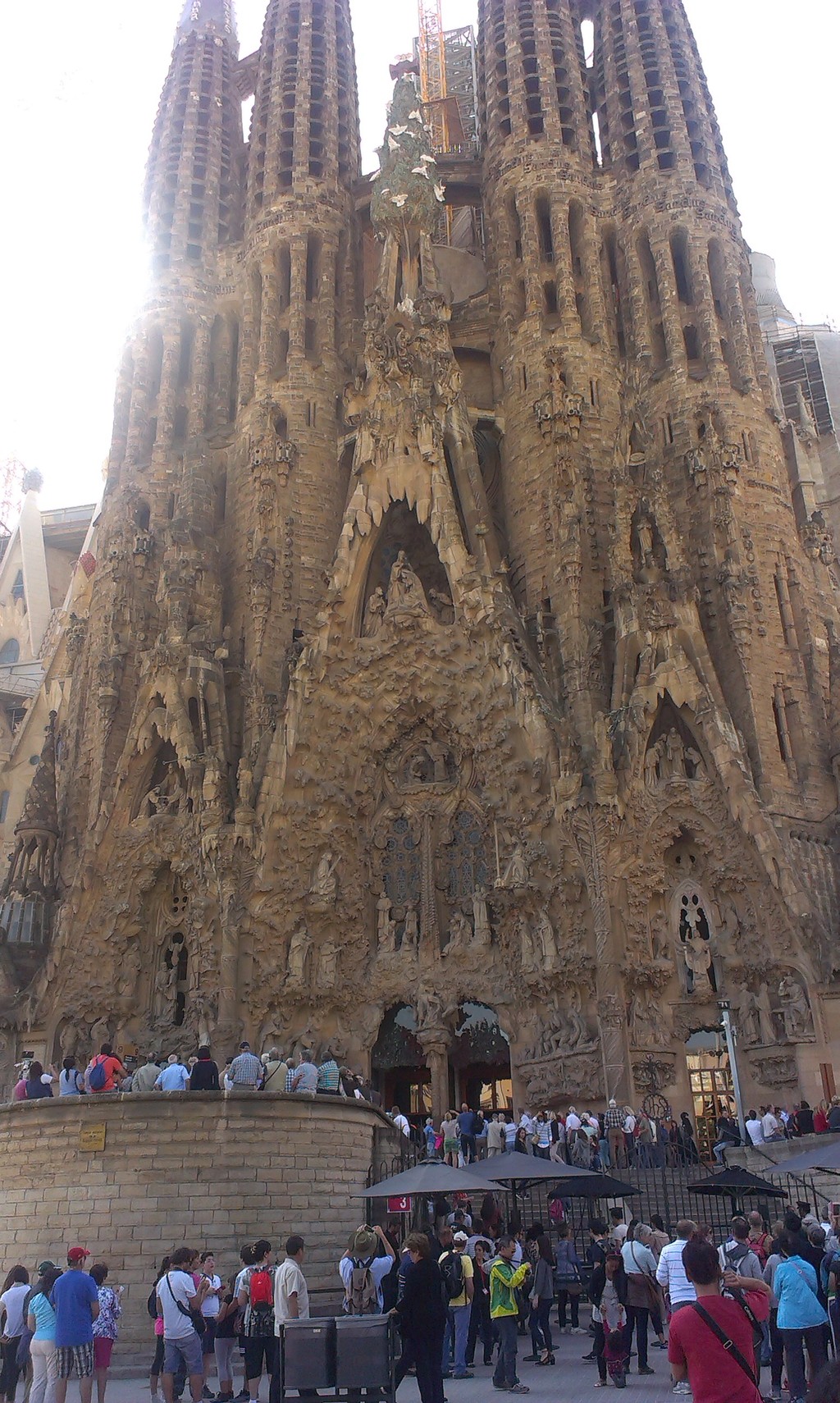
Honestly, I do not know much about the history of the cathedral, but I do know the year when the construction works have started – 1882. The construction of Sagrada Familia is supposed to be finished in the year 2026, which will be a special anniversary and also a big honour to Gaudi himself, because in 2026, it will be hundred years since he died. I wonder if he imagined it that majestic. Also, when I was at the cathedral, it seemed almost finished, so I wonder what else will they build in those ten years, because the cathedral simply cannot look any more awesome than it does now. Or can it? We will see...
How to get to Sagrada Familia?
Metro is definitely the best mean of public transport that you can use to get around the city, otherwise if you want to use the bus in such a big city, you need to know exactly where to get off. Well, maybe this is not a problem for Sagrada Familia if you know how it looks like, but I still prefer the metro over anything else.
Sagrada Familia has its own metro station, named indeed "Sagrada Familia", and situated at the junction of two metro lines – blue line L5 and purple line L2. As soon as you exit the metro at this station, you will see small signs with the outline of the Sagrada Familia, pointing you to the right direction. So, right after you come up to the fresh air, you will see the cathedral.
If you would like to get closer to it, all you have to do is to cross the road, but the view is of course better from far away, because only this way you are able to admire the cathedral's size.
In case you are wandering around somewhere in the neighbourhood, it will more than simple for you to find Sagrada Familia – you can see it from most points in Barcelona. Another day, I went up the Montjuic hill because I heard of an awesome view from up there, and indeed I was able to spot Sagrada Familia within a second or two, even if it is situated almost on the other part of the city. Yes, it really is an outstanding building.
First impression
When I was walking up the stairs that lead out of the Sagrada Familia metro station, I somehow knew that the cathedral will be behind me, but when I turned around, I was surprised how close I was to it.
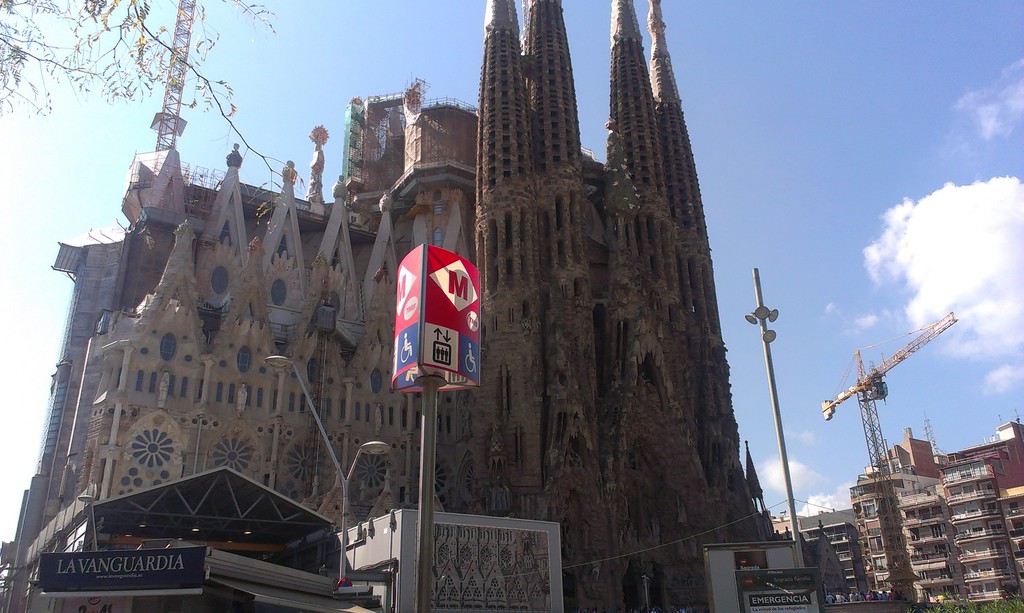
My first thought was: 'This thing is much smaller than I thought! ', but then I let the image sink in, and then I was like: 'Oh my God, this is so huge! '. Then I looked at a crowd of people, compared them to the size of the church, and ended with my mouth open! Yeah, Sagrada Familia really is huge, to say the least, so I am not sure why it seemed that small to me at first sight.
After staring at this masterpiece for a few minutes (and I even remembered to close my mouth after a while), I decided to walk all around it. And guess what? I ended up with my mouth open again! This place is so unbelievably huge, and just walking at the side makes you think it will not end. And then, when I saw the back side, which is only a slightly less majestic than the front side, I understood why it takes so long to finish building it.

Spending some time next to Sagrada Familia
Sagrada Familia is surrounded by little souvenir shops (where a small statue of the famous lizard from the Park Guell costs more than ten Euros! ) and lovely cafes and bars where you can sit down and admire the cathedral. This is actually the best way to do so, because you will not be in the middle of the crowd, so there are less chances of being robbed, also you can rest for a few minutes and you will also be far away enough that you can actually see the whole front part of the cathedral.
Well, you will still have to look up since it is so tall!
I wonder what does the view from the top of it look like and I almost envy the construction workers working on Sagrada Familia, because they are able to admire it every day.
By the way, it is funny how they photoshop the cranes out of every single picture of Sagrada Familia: I have not seen a single postcards with the cranes next to the cathedral, have you? I agree that the cathedral of course looks much better without the cranes, but why would you delete them from pictures?
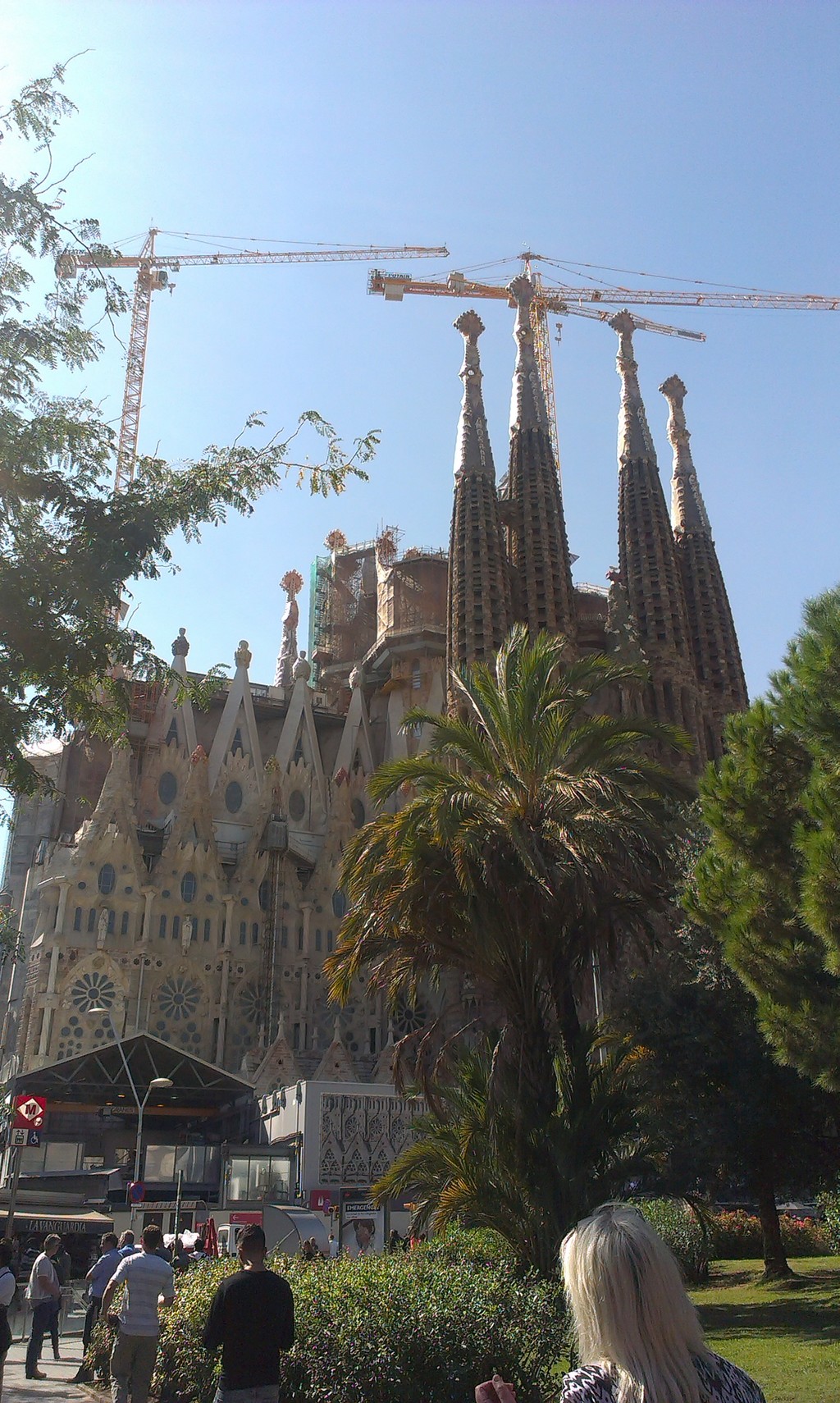
Only when I had a Frappuccino in one of those bars (it cost me four damn Euros, but I should have expected that! ), I started to look at the details on the cathedral. Again, I wonder how many hours of really hard work were put in those details: literally every inch of the walls is covered with something – either statues or carvings. And it is really beautifu!
When I went to the bar, it was mainly to rest a bit and to back away from the crowd but that did not stop the annoying sellers (which were mostly selling selfie sticks) to come to me and insisted that I should buy some of their products. And the bar staff did absolutely nothing about it, although they saw the sellers. I think that this should be absolutely forbidden!
When I was sipping my Frapuccino, I also noticed how slow the line to enter the cathedral is moving on, and it reminded of the London Eye. I can imagine that people would like to spend as much time inside the cathedral as possible, because I saw the pictures of it and it is breathtaking! But you simply cannot expect anything else than perfection from Gaudì, to be completely honest.
The entrance costs about twenty Euros, but as an Erasmus student, I received an offer of an absolutely free entrance at the end of the month. Actually, anyone can 'purchase' those free tickets - the catch here is that they will only give out a limited number of them. The tickets are meant for the "open days" of the Sagrada Familia, and if you ask me, this is a really nice promotion.
What you have to do is to visit the website of the cathedral on an assigned date, and sign up for the tickets. Too bad that you can do this only on the Catalan part of the site, but this is why we have Google Translate, so it should not be a problem to translate the site to your preferred language.
There is also an assigned time when you have to redeem your ticket in order to be eligible for a free visit - the visits will take place during the last weekend of October, and they will only last for a few hours each day. I have heard that last year, the tickets were grabbed in less than three hours! So you have to be really fast, but I am sure that the prize - seeing the interior of the cathedral - is worth it.
Of course I will grab my ticket and go see the interior, and I will keep you updated about how great it was. I just hope that we will not have to stand in line for several hours! Well, to be honest, I would actually do even that, since I really want to see the interior of Sagrada Familia.
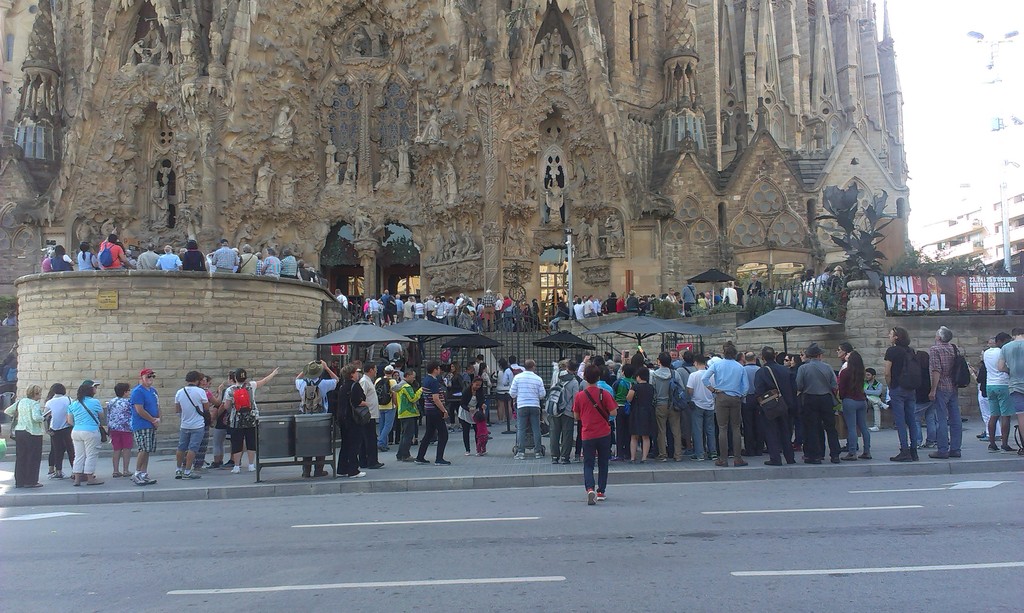
Robberies and scams
Before I went to Barcelona, I have read that the pickpockets there are really good ad their job and that the Sagrada Familia is one of the 'best' spots in the city for being robbed. So I was really paranoid before I went to the cathedral. Usually, when I go somewhere, I carry the following items in my bag: keys, wallet with all cards and money inside, both my phones and camera. And possibly something else.
So when I heard of the robberies, I have decided that I will take a moneybelt with me, where I will put my phone, money and keys, and I will also take the ordinary bag, containing only tissues and umbrella, distracting the potential robbers. But honestly, I did not feel endangered at all, and there was no one close to me that I would assume he wants to take something from me. Or maybe they did, and they are really good that I did not notice, but I doubt so.
I have heard of two most common scams there – one of them is happening on the subway. Be prepared that the Sagrada Familia station is always very busy. What happens is basically that the group pushes you to the wall or to the train, pretending someone pushed them, and when you are trying to get your balance back, they go through your stuff and take whatever they want.
The second scam happens in front of the cathedral: some people will be pretending to be lost or ask you some random questions. And while you will be all confused and think of a possible answer, the group will approach you from behind so you would probably not even notice that they went through your backpack or purse.
But do not freak out and stay home because of that! It is safer than I have read, and there is also a lot of policemen in yellow vests, patrolling around. I am not saying that it can not happen to you, but it is not very likely, if you take care of your stuff and do not wear too much bling bling jewellery on you.
Conclusion
Please, just do not dare to leave Barcelona without seeing this amazing cathedral! Even if you decide to only see the outside part, it is more than worth to go there. I guarantee you that it will leave you absolutely speechless. And please, also go to Sagrada Familia when it is dark already – there is some amazing lighting on the walls. Well, the lightshow at the 'Magic fountain' of Montjuic is still better, but after all, not many people can say that they have seen the cathedral of Sagrada Familia at night. And if, apart from Sagrada Familia, you want to know further information about what to do in Barcelona, this post will help you.
Photo gallery
Content available in other languages
- Français: Plus qu'une cathédrale
- Polski: Coś więcej niż zapierająca dech w piersiach katedra
- Italiano: Più che una cattedrale mozzafiato
- Español: Mucho más que una catedral
- Nederlands: Meer dan een adembenemende kathedraal
- Português: Mais do que uma catedral de tirar a respiração
- Türkçe: Nefes kesici bir katedralden daha fazlası
- Deutsch: Mehr als eine atemberaubende Kathedrale
The Sagrada Familia
The Sagrada Familia is a Basilica found in Barcelona and is the most visited monument in Spain, which doesn't surprise me, as it is astonishing. So much so, it has become a national symbol.
Its construction began in 1882 but is still not finished. According to the signs posted up it won't be finished until 2026, but who knows what could happen.
It was designed by Antoni Gaudí, an architect who designed other important constructions in Barcelona such as Park Güell and Casa Batlló. The part of the Cathedral that he'd designed was declared a World Heritage Site by UNESCO and was also a candidate for the New Seven Wonders of the World.

It's made up of 18 towers (of different heights), 12 Apostles, 4 Evangelists, and a statue of Jesus Christ and the Virgin Mary.
Although I didn't go inside, I absolutely loved the windows. What surprised me the most were the amount of colours and contrasts- I've never seen church windows like it.
I've visited the Cathedral twice; once when I was 13, and the other time in May this year.
The first time I went I was disappointed. If I remember correctly, I wasn't happy that the towers were under construction, meaning I didn't get the chance to see it. However, you could tell that if it wasn't under construction, you'd be able to see why it was considered superior to other monuments. The second time I was luckier, and it was like seeing a different building, I guess when we're younger we think different things so therefore 'see' different things; even if it's the exact same thing we see when we're older. This time, I noticed and appreciated the grand scale of its endless detail. You should go round it all and take your time doing so because every part of it is like an independent entity that deserves time to be well observed. I was continuously surprised as there are details that you gradually notice when looking at all the details.
It's really different to all the other Cathedrals and Churches I've seen, as I kind of see it as a more modern model of a Cathedral, especially its interior, and the towers also give it a distinctive touch.
First, we saw the Passion Façade, which is darker and more austere compared to the other three as it is supposed to reflect Christ's suffering. I was impressed immediately. We saw statues of people in the towers, but they were at different heights.
The Plaza de la Sagrada Familia, is like a square garden, simple but nice, although you'll probably be more distracted with the Sagrada Familia in the background. You can take some good photos from there of the Cathedral with the flowers from the garden making a good frame for the photo.

The Nativity Façade is my favourite and contrasts with the one before; it has many details which reflect the joy of Jesus' birth. The façade has three doors, one of them being the main door. I don't really know how to describe them as you really have to see them in order to imagine them. It was hard to take a photo here because it was full of tourists, many with cameras in hand, and they would keep interrupting the photos I took by walking in front of the camera.
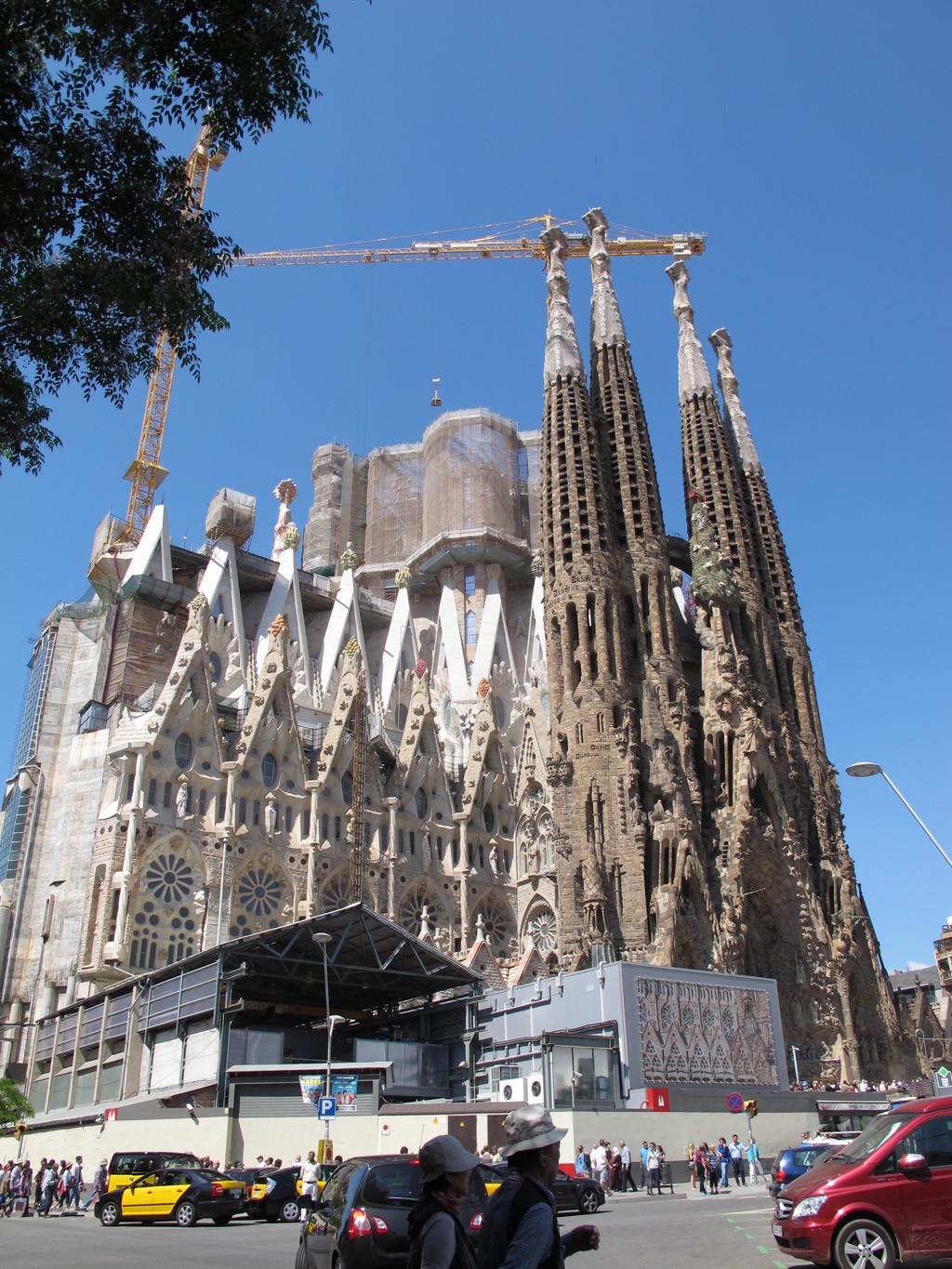
This façade contains the Plaza de Gaudí, also in the shape of a square, but bigger than the Plaza de la Sagrada Familia. It's a cultivated garden with a pond in the centre and most of the best photos taken of the Sagrada Familia are taken from opposite the pond so the pond is pictured just below the basilica, like this:

The Glory Façade is the main façade where you go inside (when it's finished). It was under construction so I couldn't see it very well, but I guess from its name and the style on the outside, the inside is probably very spiritual and bright.
I really liked the cloister because it greatly contrasted with the rest of the church; its light colours and low, horizontal shape that lead up to higher parts of the Cathedral into cone shapes had really distinctive colours. It surrounds the whole basilica, except for the three important doors.

We couldn't enter as we didn't know that we had to get tickets in advance and the queue was huge. From what I've seen on TV and elsewhere, the interior is beautiful and impressive so I'll have to come back and look inside... perhaps when it's finally finished!
The visiting times are from October to March 9am to 6pm, and from April to September 9am to 8pm. You can climb up to the towers during these times by foot, but if you want to use the lift then be aware that it closes a half hour before the basilica.
The basic rate to enter is 15€, but it gets a bit more expensive if you want a guide or to go up to the towers. If you're planning on visiting other sites in Barcelona then you might be interested in getting a package deal where you can visit other places like Park Güell, which are also available with or without a guide. Also, you get a discount on tickets if you're a student, under 18, or a pensioner.
There's a metro stop, 'Sagrada Familia' (line 5) with two exits; one is 'Plaza de Gaudí' and the other is at the back of the Cathedral on a street called 'Carrer de Provença'.
There are several restaurants and fast food joints near the Sagrada Familia, and you can also find the beautiful Hospital de Sant Pau which is just a 5 minutes walk away.
Photo gallery
Content available in other languages
- Español: La Sagrada Familia
- Deutsch: La Sagrada Familia
- Polski: La Sagrada Familia
- Italiano: La Sagrada Familia
- Français: La Sagrada Familia
- Português: A Sagrada Família
A visit to The Sagrada Familia
An emblematic monument of Barcelona designed by the architect Gaudi, that will in my opinion stay ingrained in the memory of any one who visits it. Its height, its scale, its towers and its colourful interior render the visitor speechless. As we had already bought our tickets online, we didn't buy our tickets on site and thus avoided the never-ending queues that often result in having to return later. In fact, because of the sheer volume of visitors, access is limited to a certain number of visitors during a fixed time bracket. So it was only after gazing upon the Sagrada, taking an incalculable number of selfies and photos of it and its cranes we went inside. The outside view is even more incredible from the other side of the park opposite.
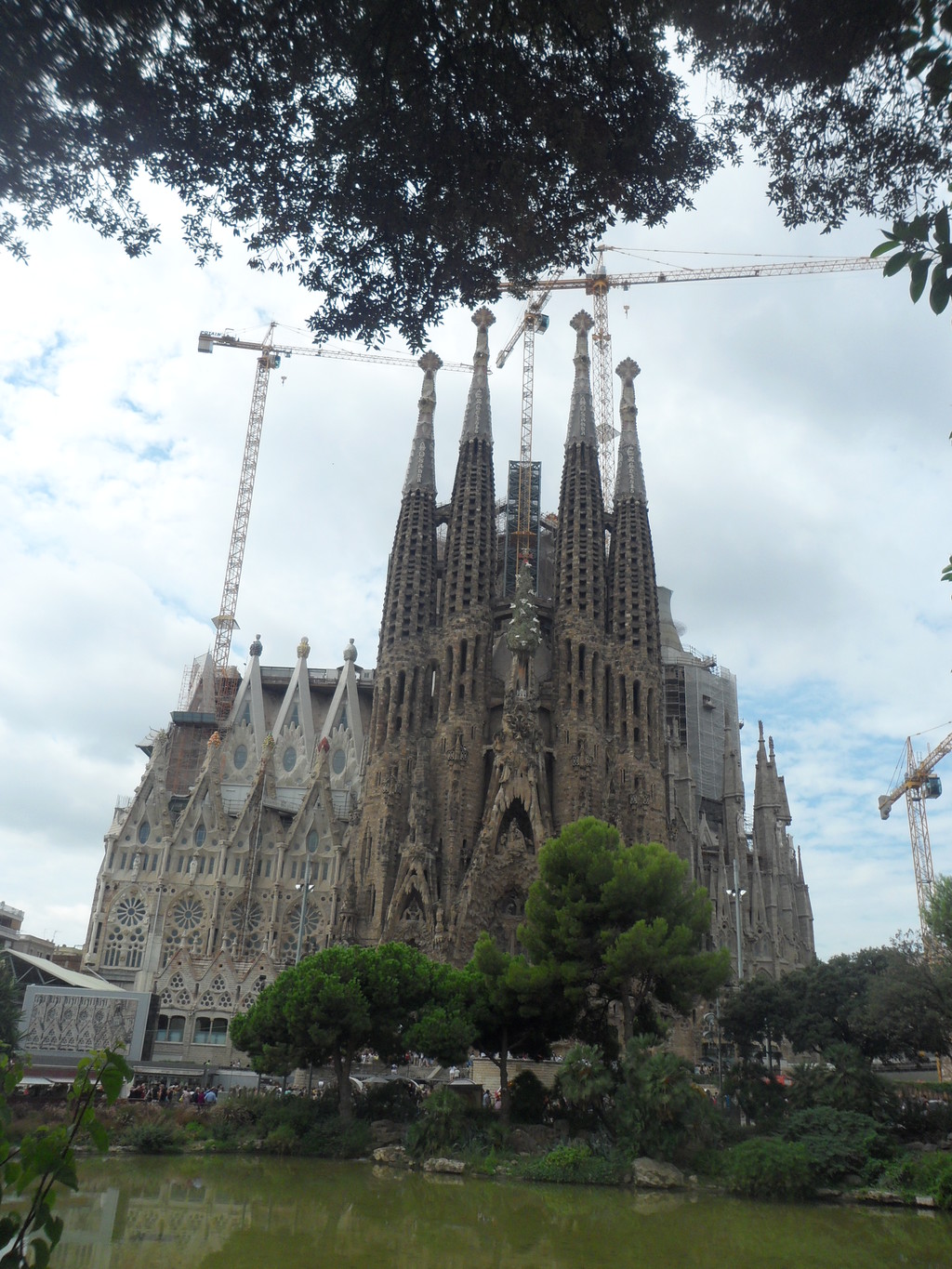
We were impressed from the get go by the height of the structure and its internal architecture. We didn't rent an audio guide so we followed a spontaneous route throughout. We went, first of all to the right, where we admired a small chapel for prayer. Our eyes were, however, constantly diverted upwards to contemplate the very colourful stained-glass windows. Thanks to a small window, we were able to see that there is another larger chapel situated on a lower level of the Sagrada, however it is not accessible to tourists. At this point we found ourselves asking again, how does the Sagrada stay standing?

This monument proves to be so big and so tall, that the work of the architects and builders is amazing. Next, in the centre of the church is the area for the main mass ceremonies, with an organ at the back that's lit up by a hanging lamp. Many people were sat on the pews, either to pray or to bask in the beauty surrounding them.
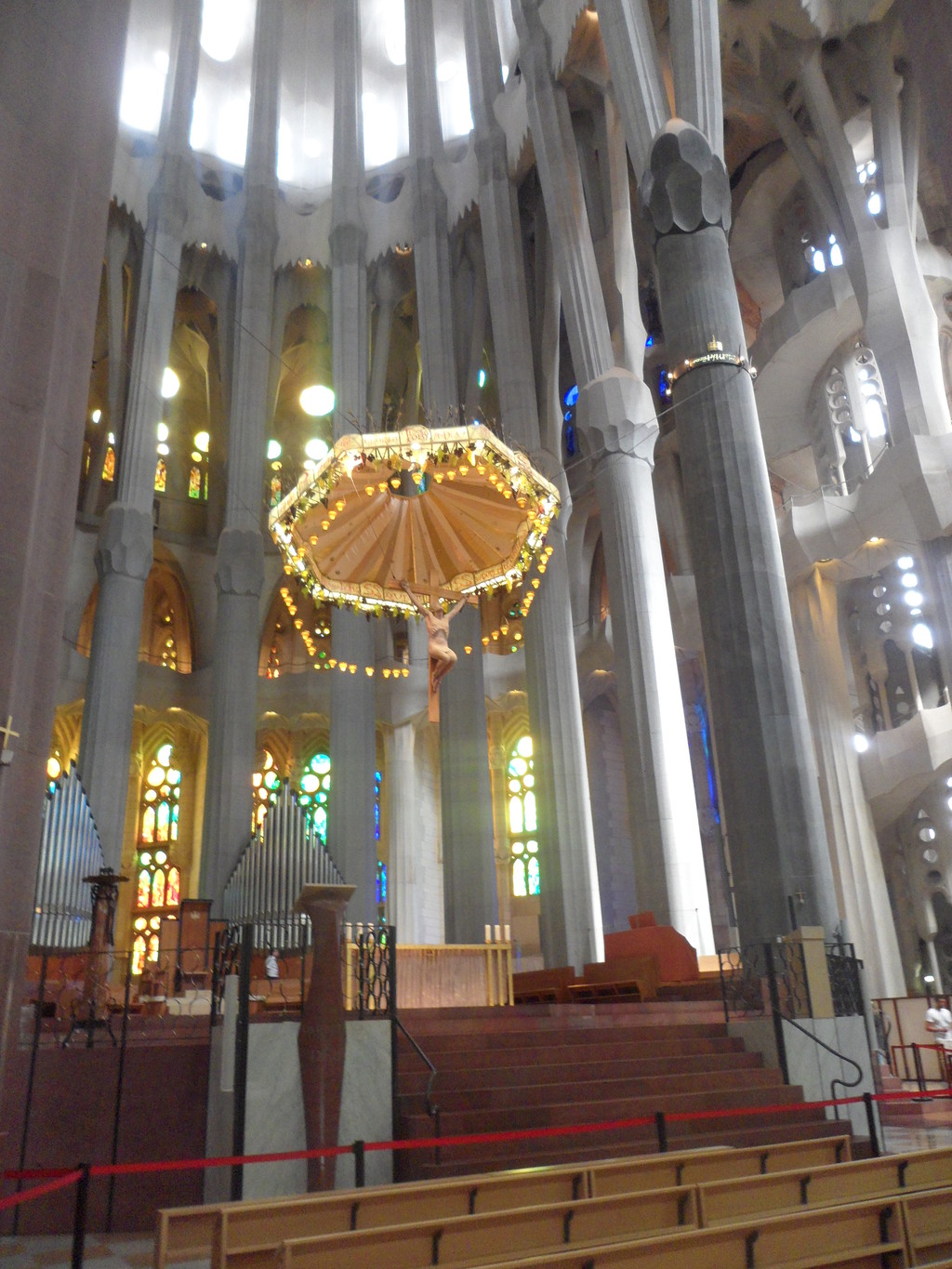
The closer we got to the back of the church, the more we worshipped the stained-glass windows. On our left, we were hit by magnificient rays of blue and green and on the other side we went from red to orange to yellow. Despite quite cloudy weather earlier, the sun, thankfully penetrated the windows to colourfully reflect around the church. I was bedazzled by this phenomenon!

However, you need some patience, because as a piece of organ music played in the backround, a pneumatic drill began its own song. Builders work constantly on this work of art, and we can't be angry at them for that. After walking around the church, we passed by the bronze central doors of the facade, created by the sculpter Josep. M Subirach with their carvings of the texts of the Gospel of St Thomas and Saint John, that recount the last days of Jesus' life.

At the end of the visit you can stop by the souvenir shop. With its shot glasses, mugs, books, mini paintings and other interesting items for sale, however these are at extortionate prices, obviously. Around the outside of the Sagrada generally, we are confronted by a lot of scaffholding and cranes, which leads us to wonder : what will it be like when it's finally finished in 2026? The visit costs 15 euros for around thirty minutes. Unfortunately, this doesn't include the cost of a tour, you'd have to pay even more for that. In the end, all that's left is business...
Photo gallery
Content available in other languages
- Français: Visite de la Sagrada Familia
- Español: Visita a la Sagrada Familia
- Italiano: Visita della Sagrada Familia
- Polski: Sagrada Familia, zwiedzanie
Facts about Gaudí's Sagrada Familia
Sagrada would not be what it is today without the obsessive genius of Antoni Gaudí. Hence, it’s hard to believe that he was not the first pick to be its architect. Initially, the project was entrusted to the official architect of the diocese, Don Francisco de Paula del Villar y Lozano. He drew his neo-gothic plans and the construction began in 1882. Gaudí joined the team in 1883 as a junior assistant. However, Villar only managed to complete the crypt before he abandoned the project because of disagreements.
Sagrada Familia is not a cathedral
Many people mistakenly believe Sagrada Familia is a cathedral. Don’t worry if you thought so as well. It’s easy to make this assumption because of the size and lush design of the church. The true Barcelona cathedral is The Cathedral of the Holy Cross and Saint Eulalia in Barri Gotic.
The church of Sagrada Família was supposed to be a neighborhood church dedicated to the holy family. It’s Gaudí’s vision that transformed it into a piece of art. Thanks to its popularity, in 2010, Pope Benedict XVI granted the church a status of a minor basilica.
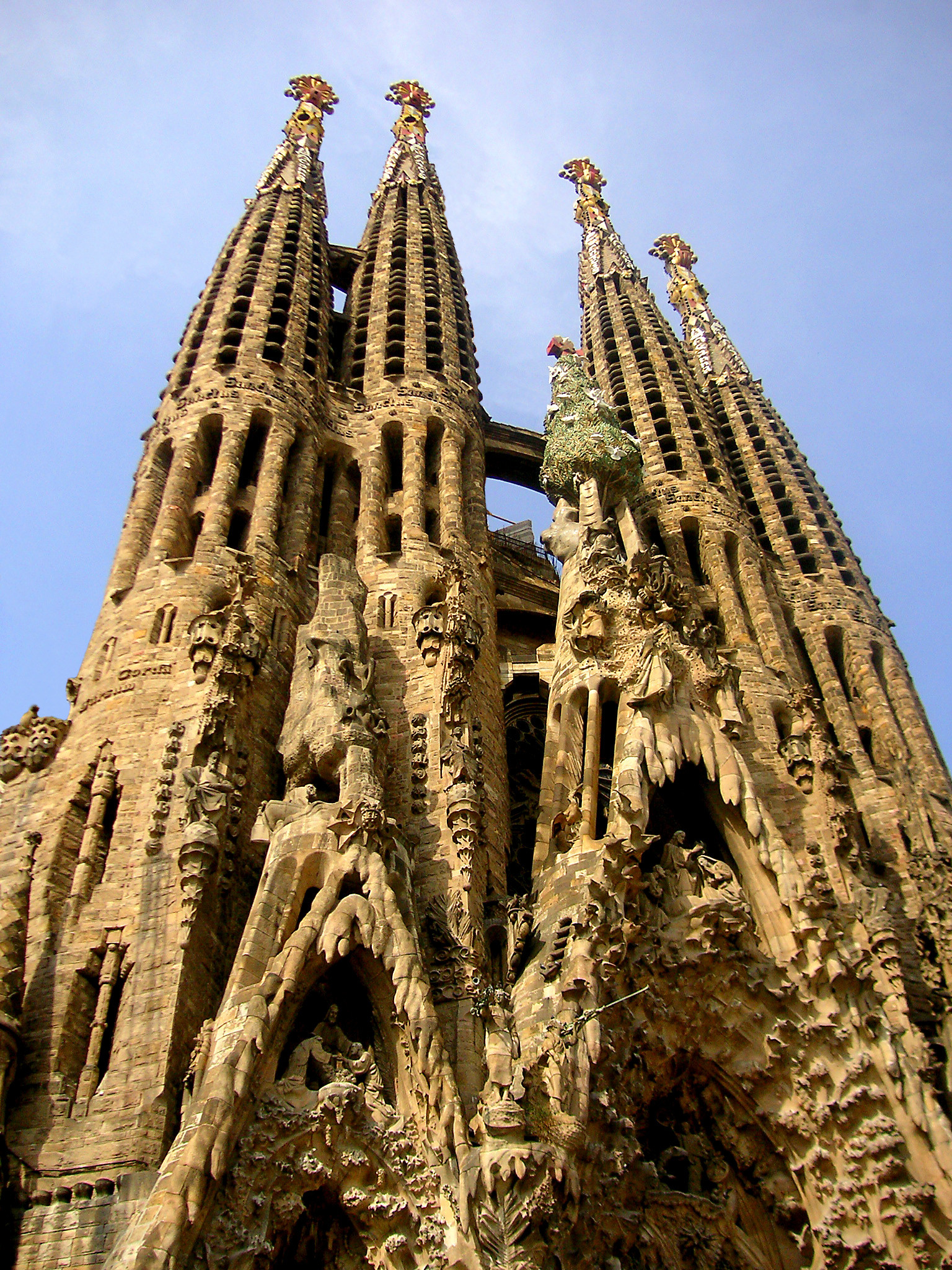
Photo gallery
Content available in other languages
- Español: Información sobre la Sagrada Familia de Gaudí
- Français: Faits sur la Sagrada Família de Gaudí
- Italiano: Fatti sulla Sagrada Familia di Gaudí
- Polski: Kilka faktów o Sagradzie Familii Gaudiego
- Português: Factos sobre a Sagrada Família de Gaudí
Rate and comment about this place!
Do you know La Sagrada Família? Share your opinion about this place.















































